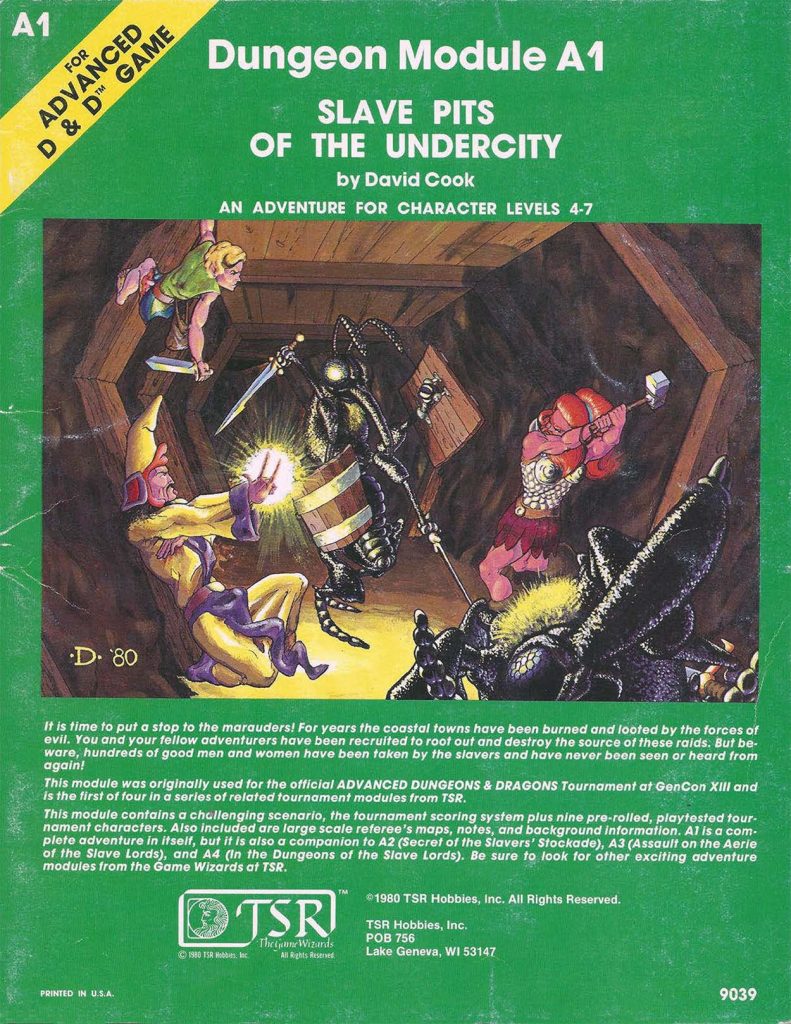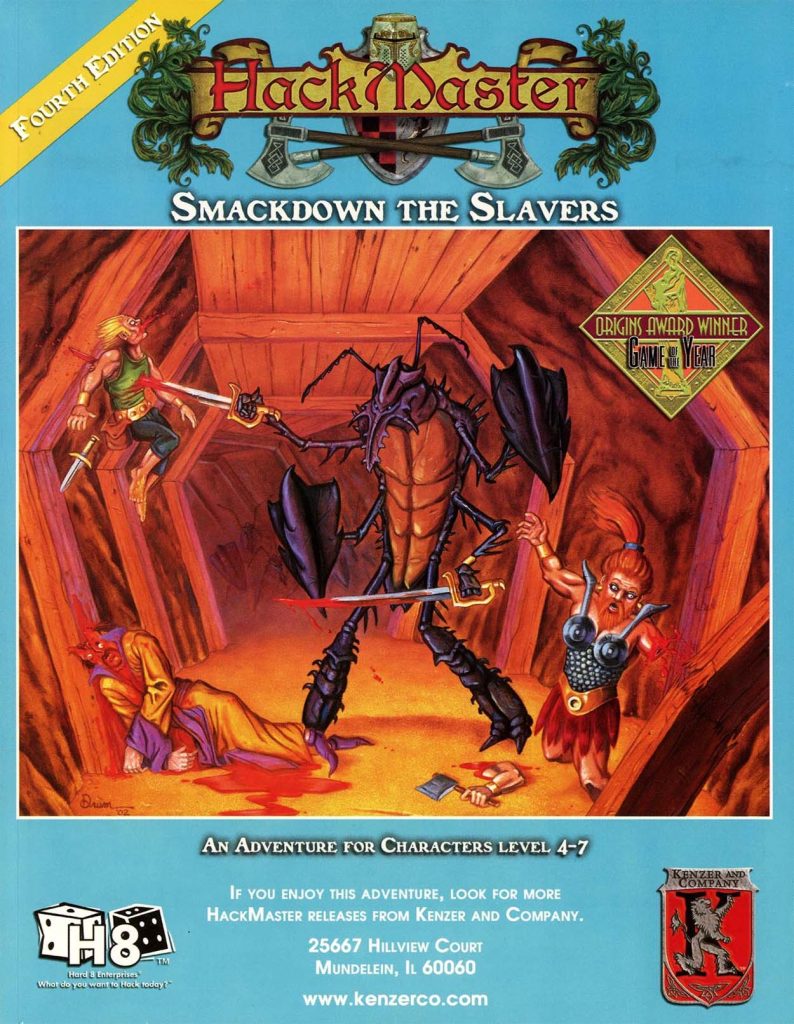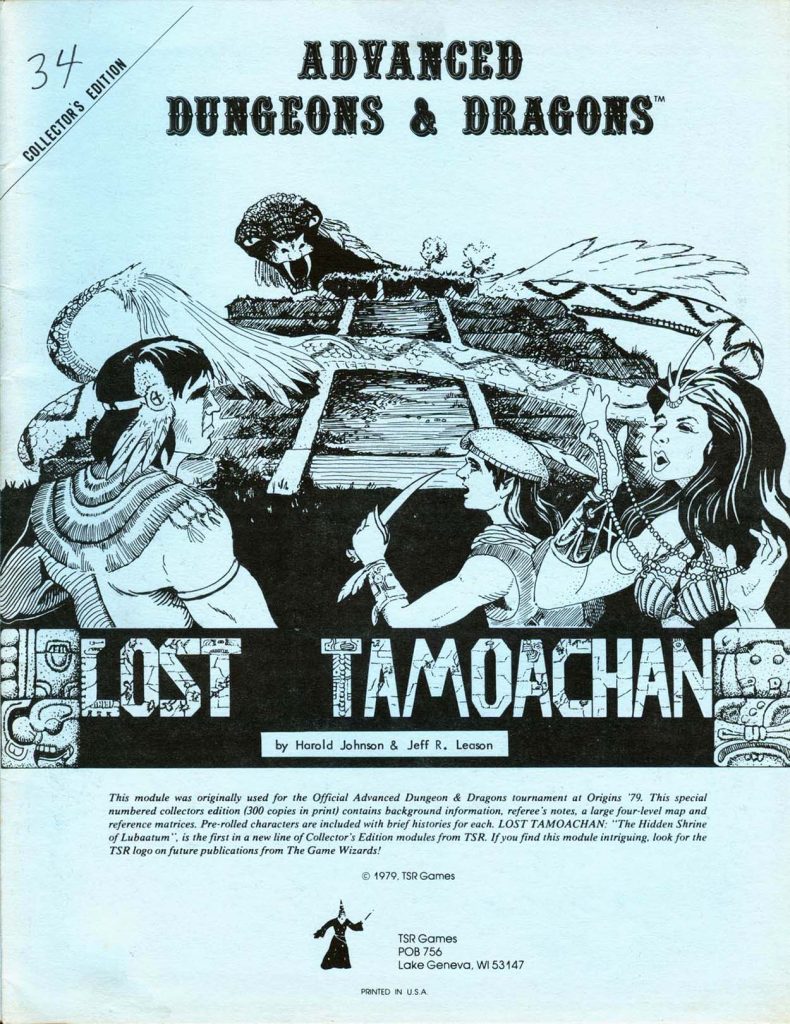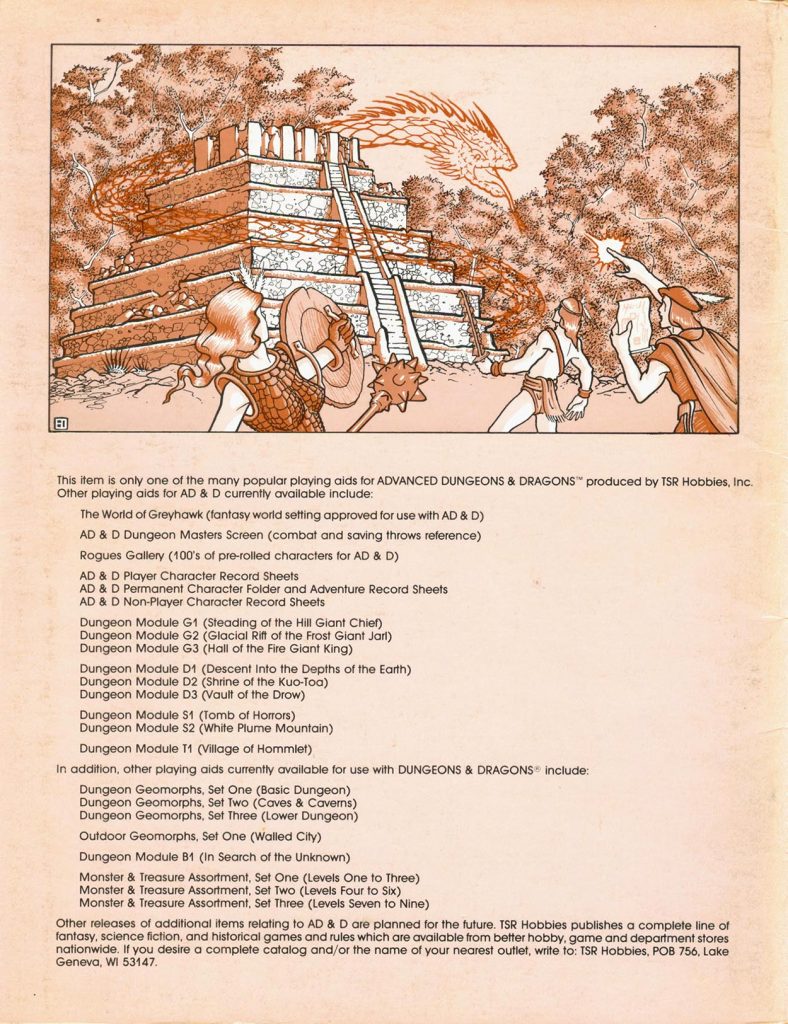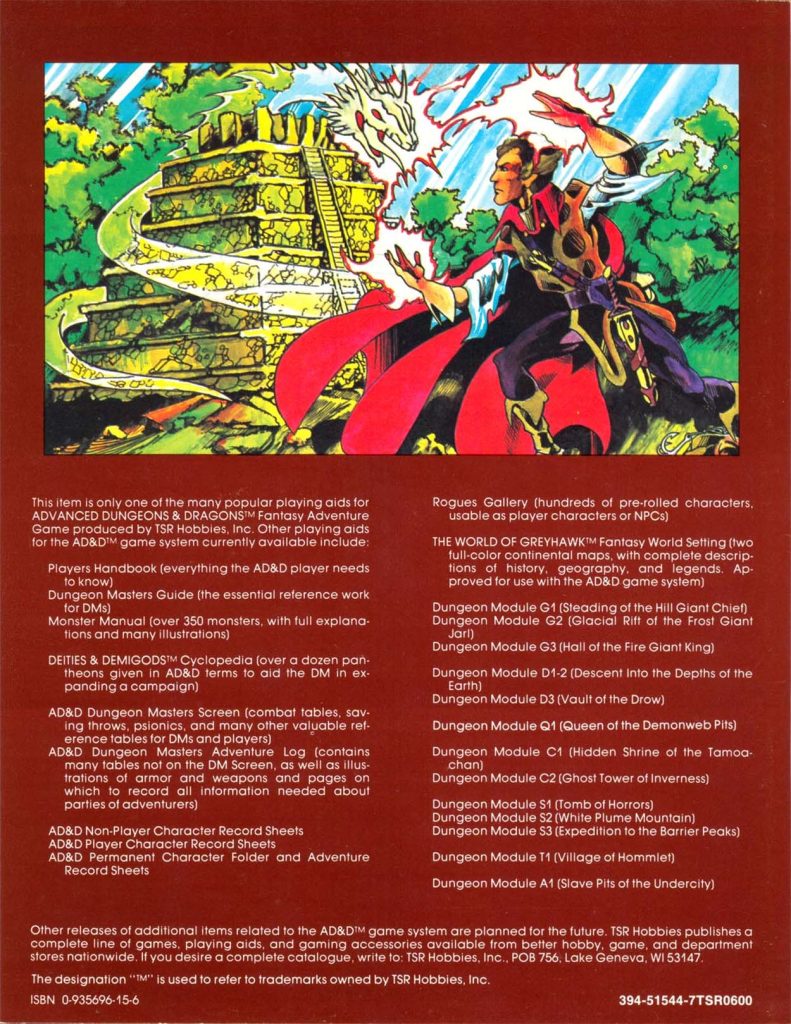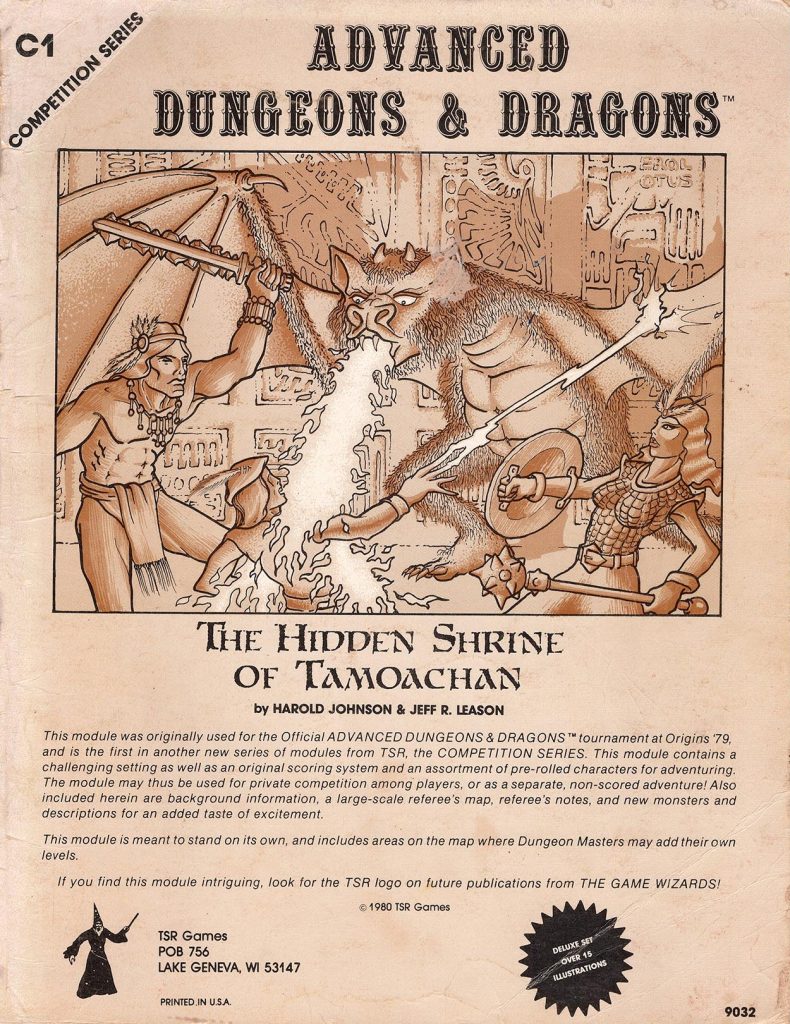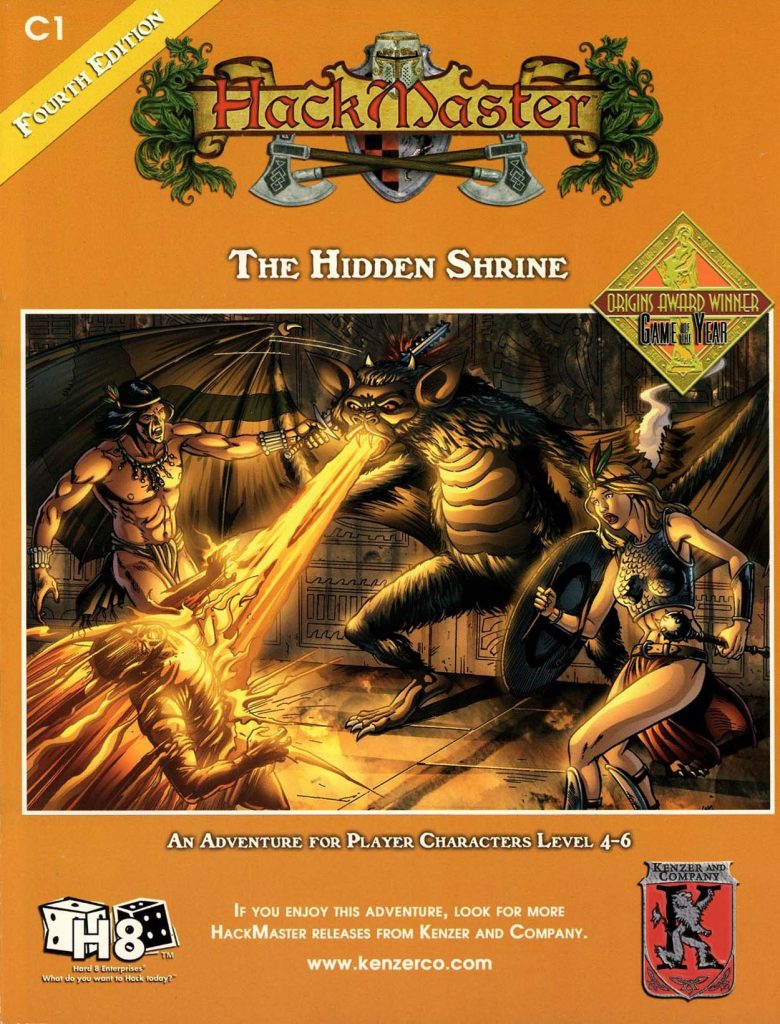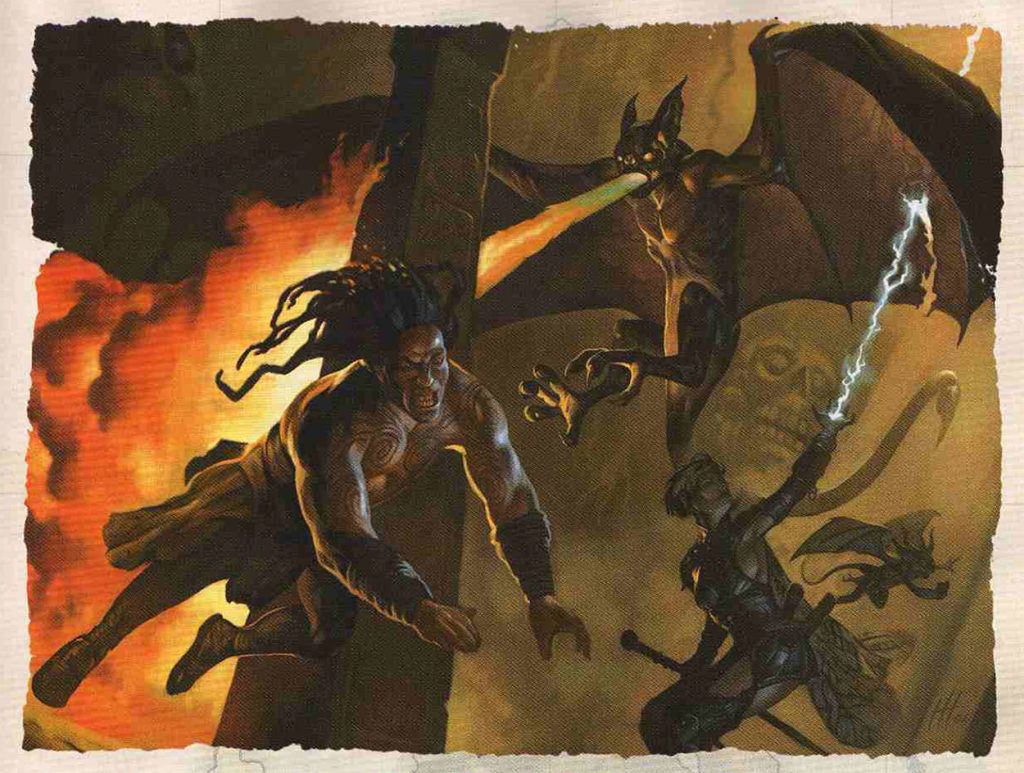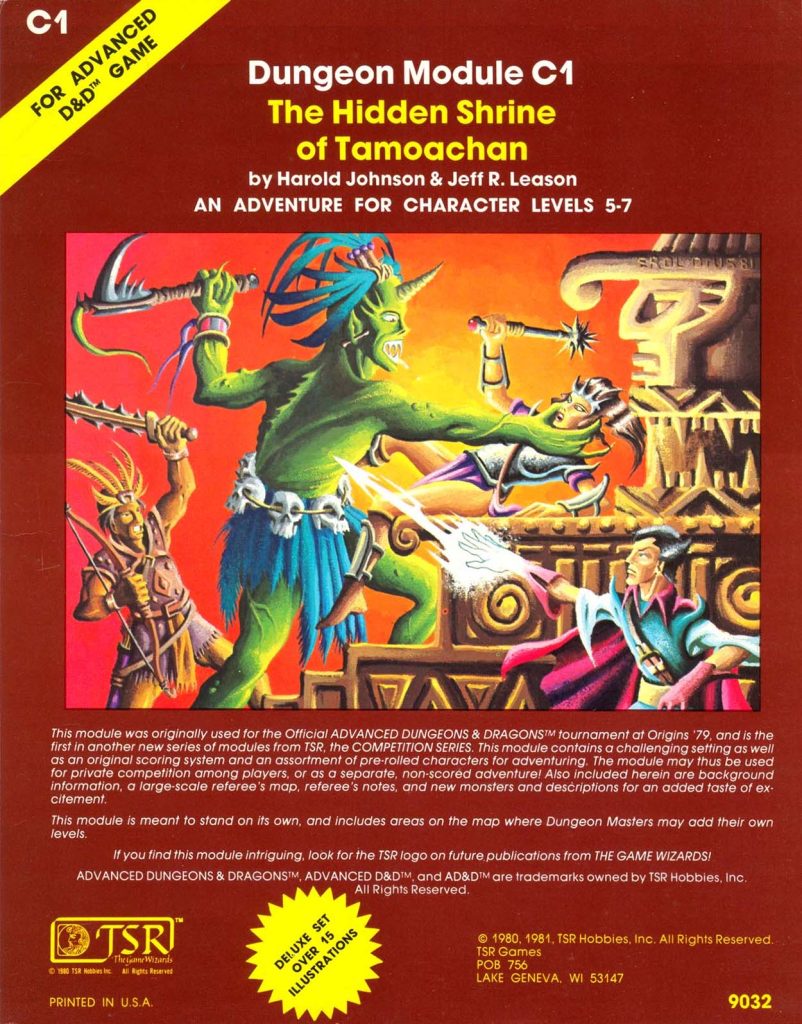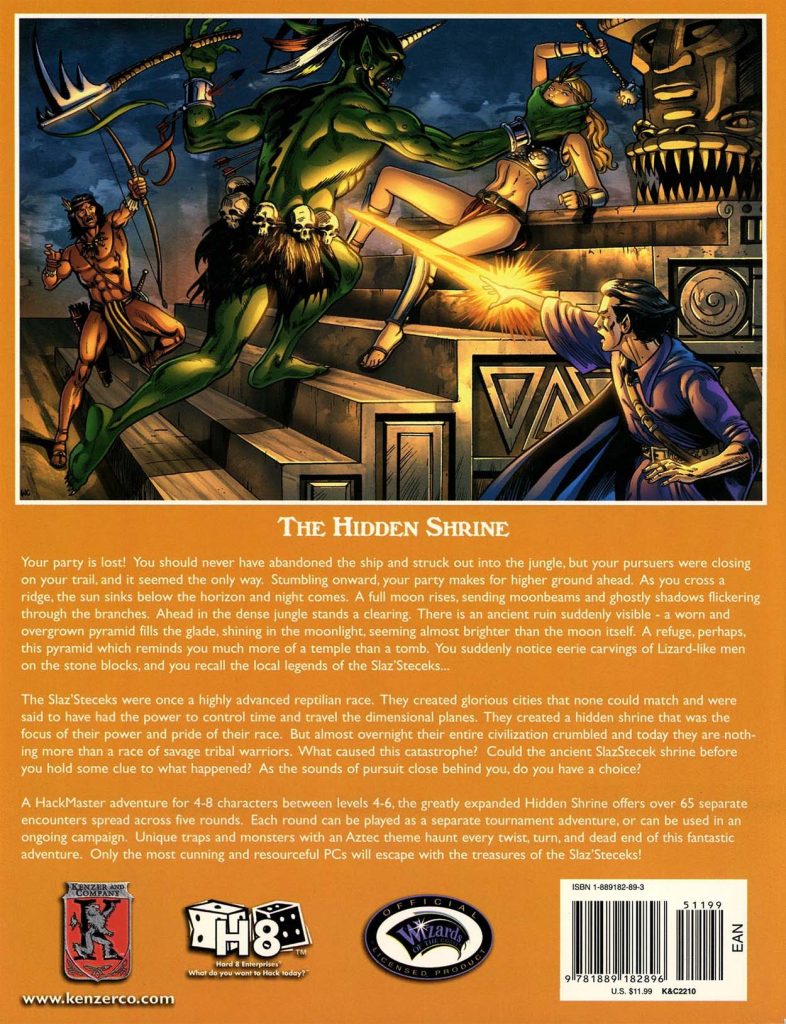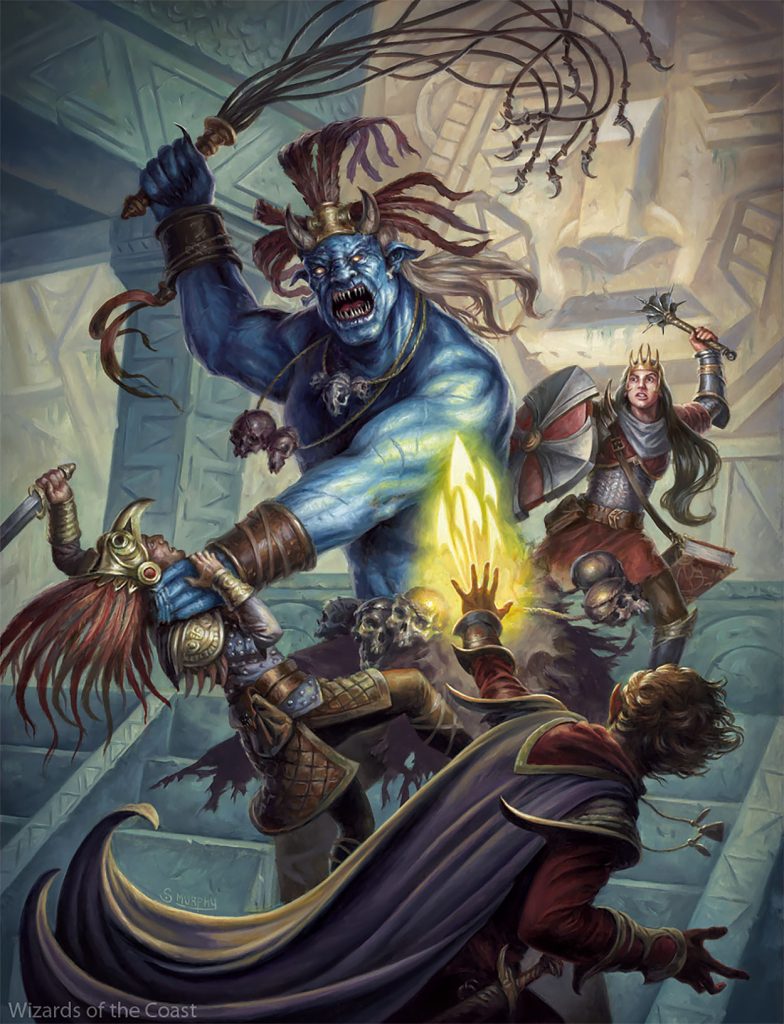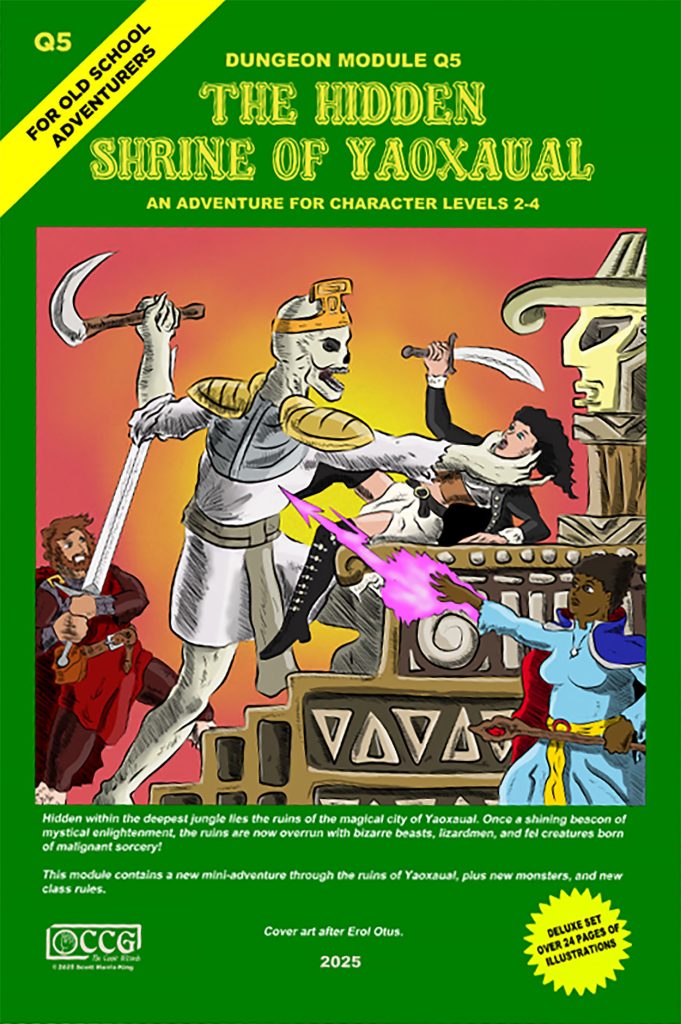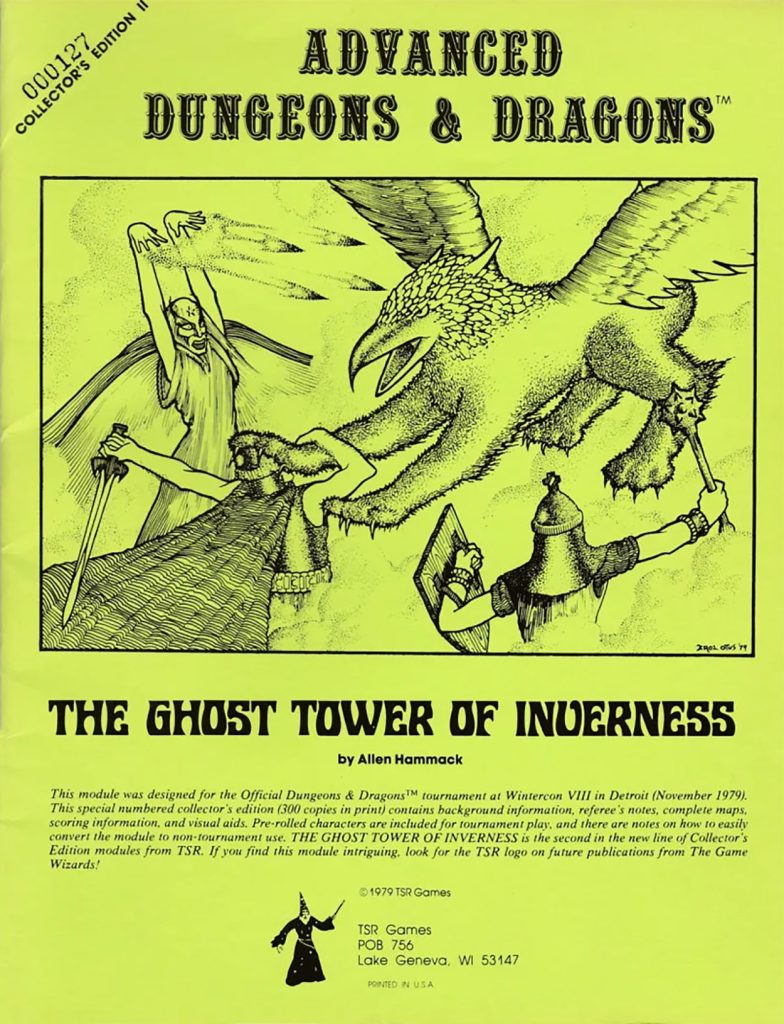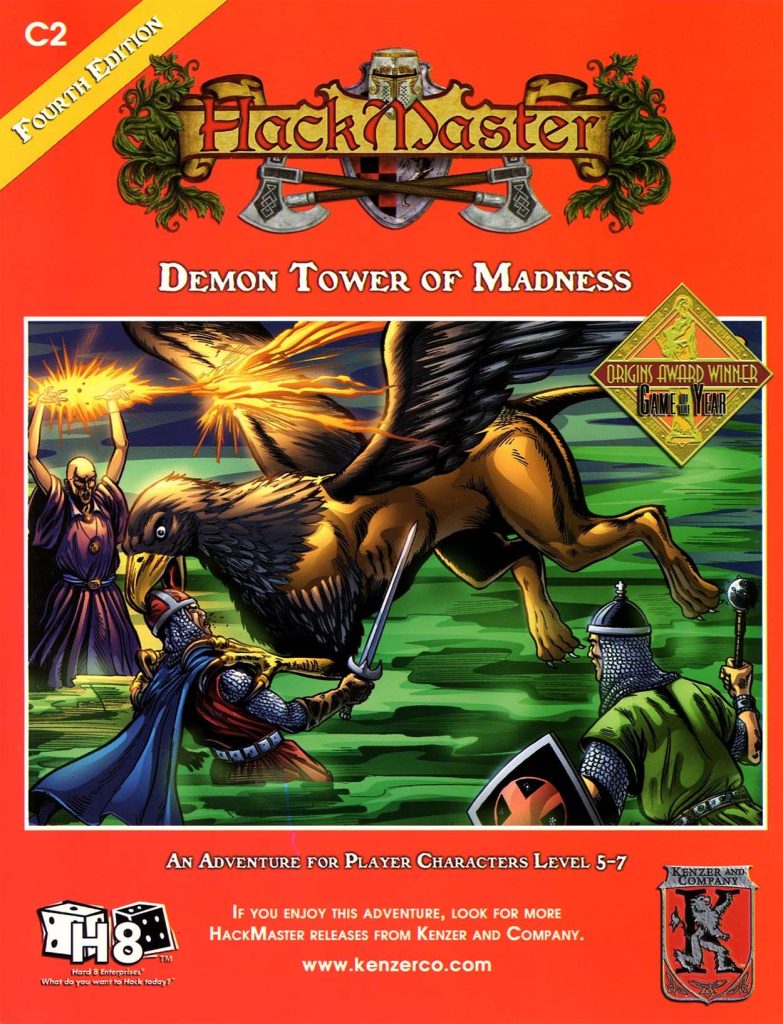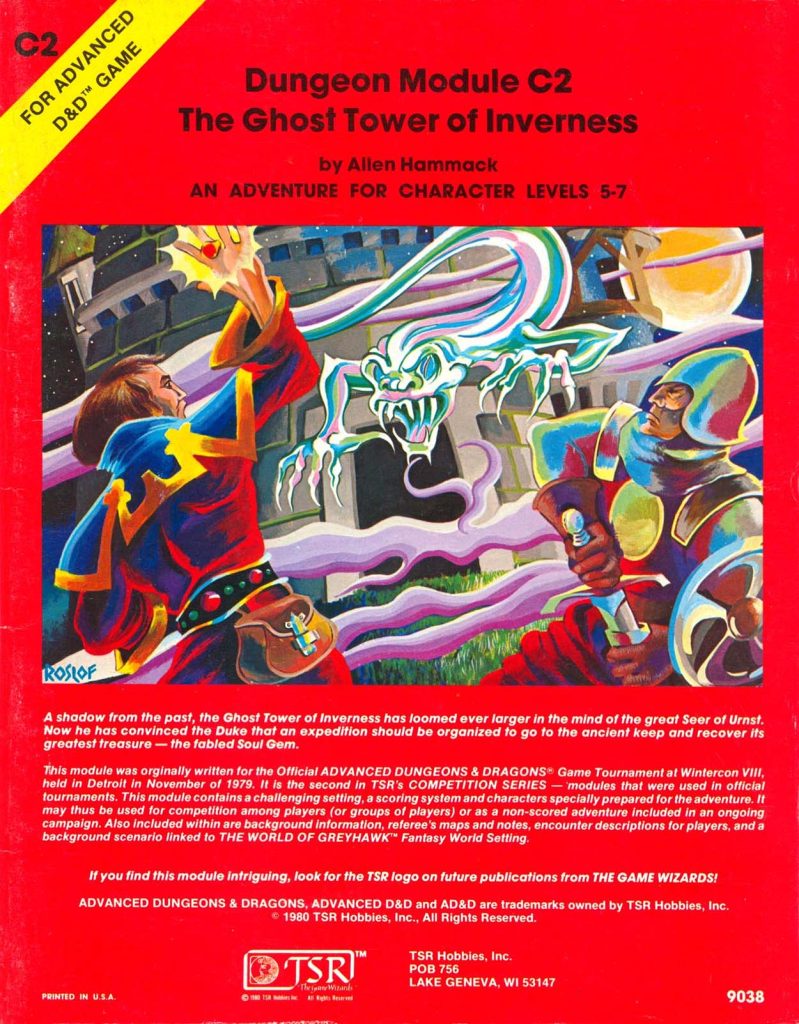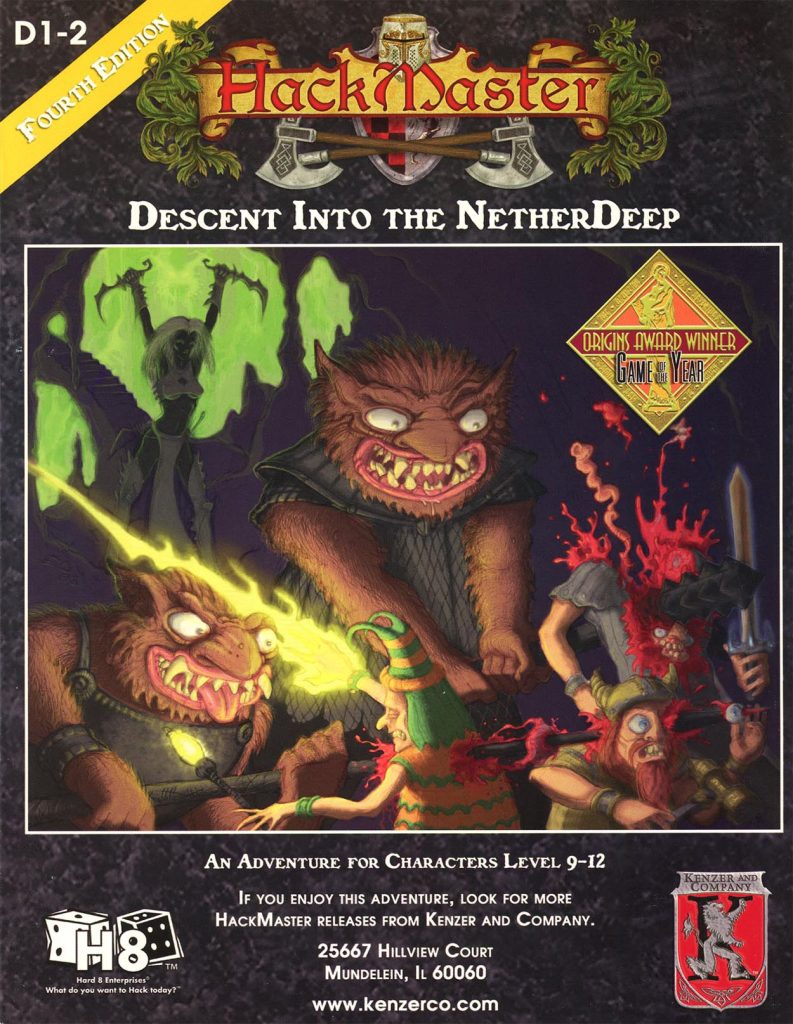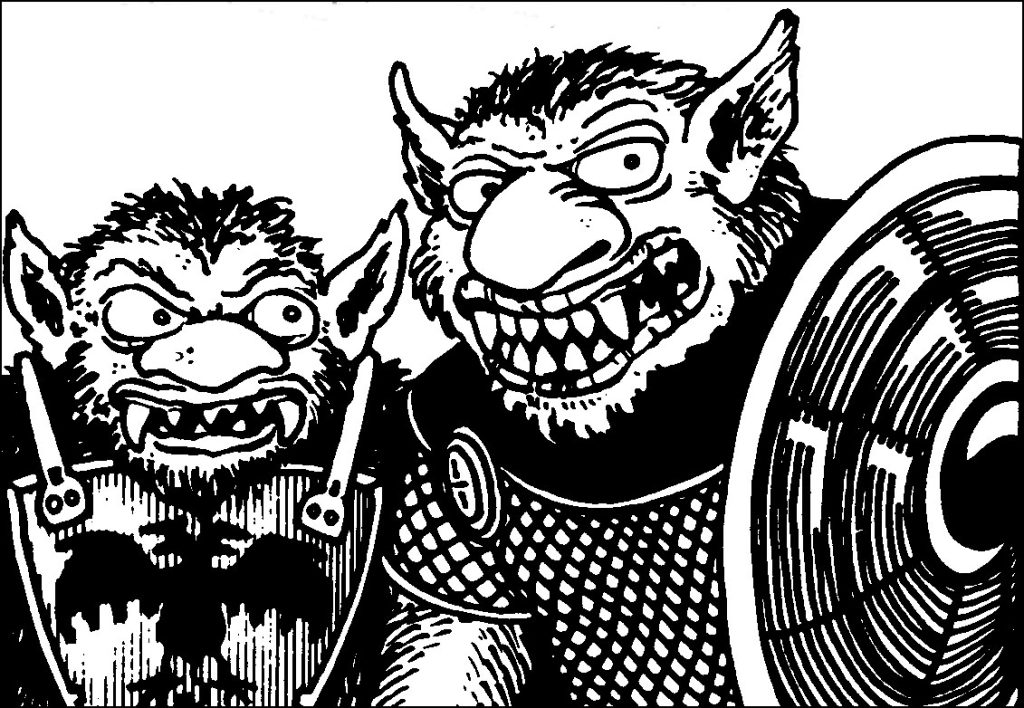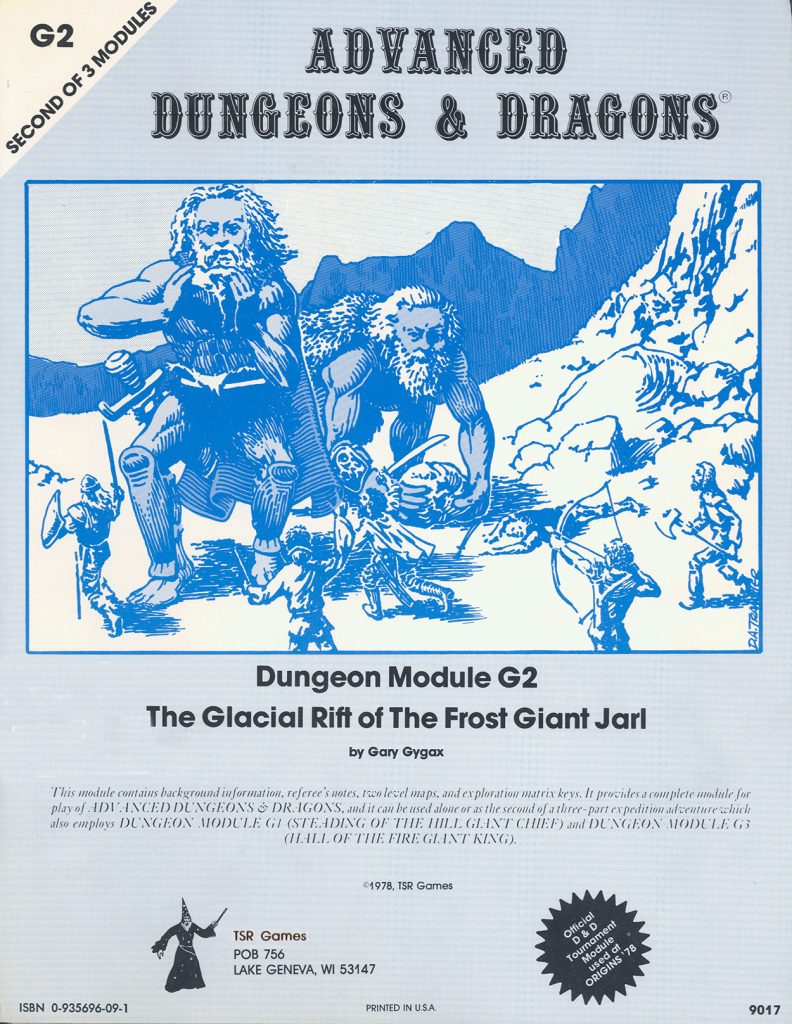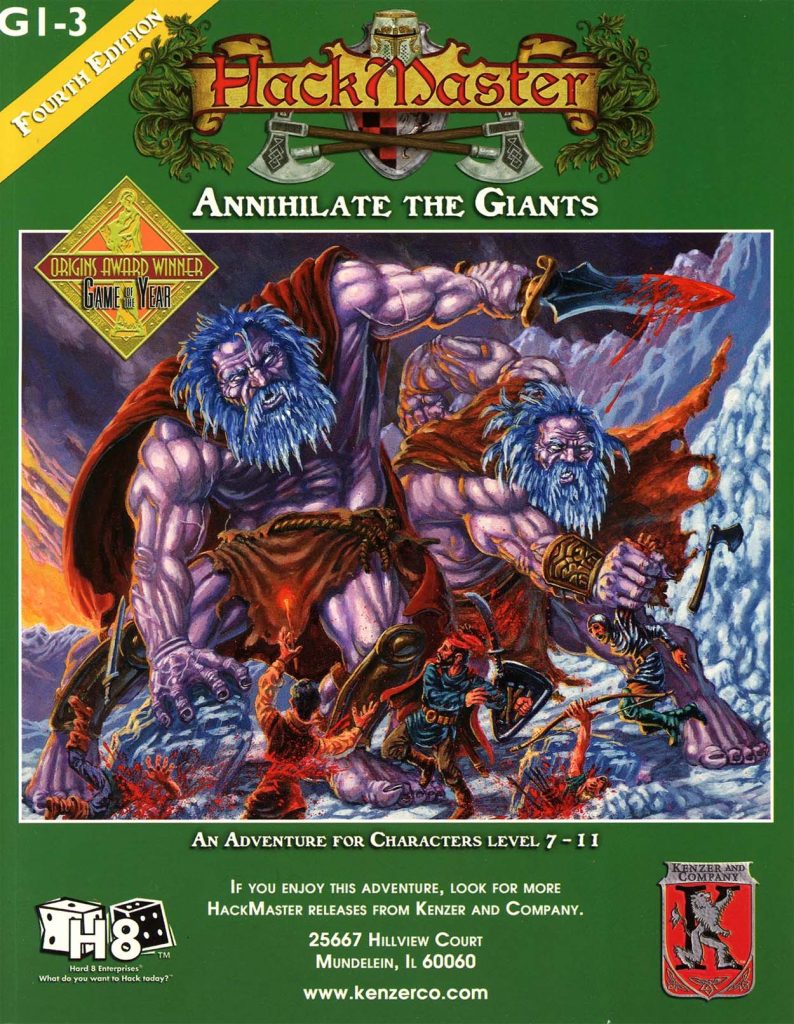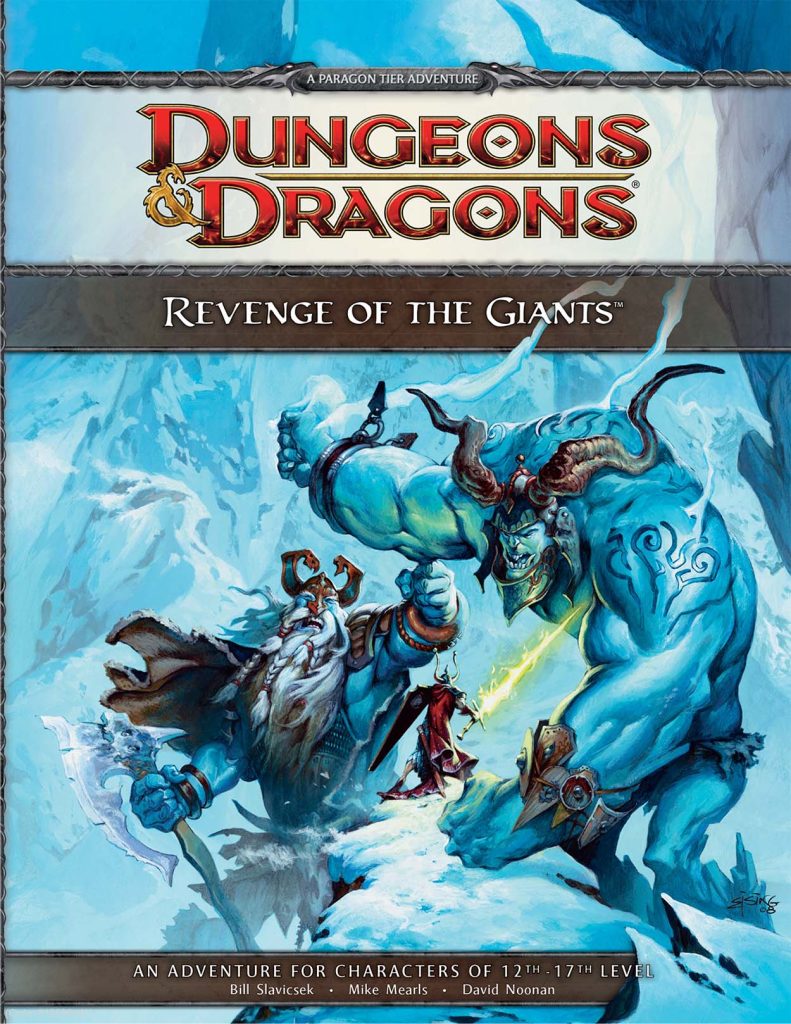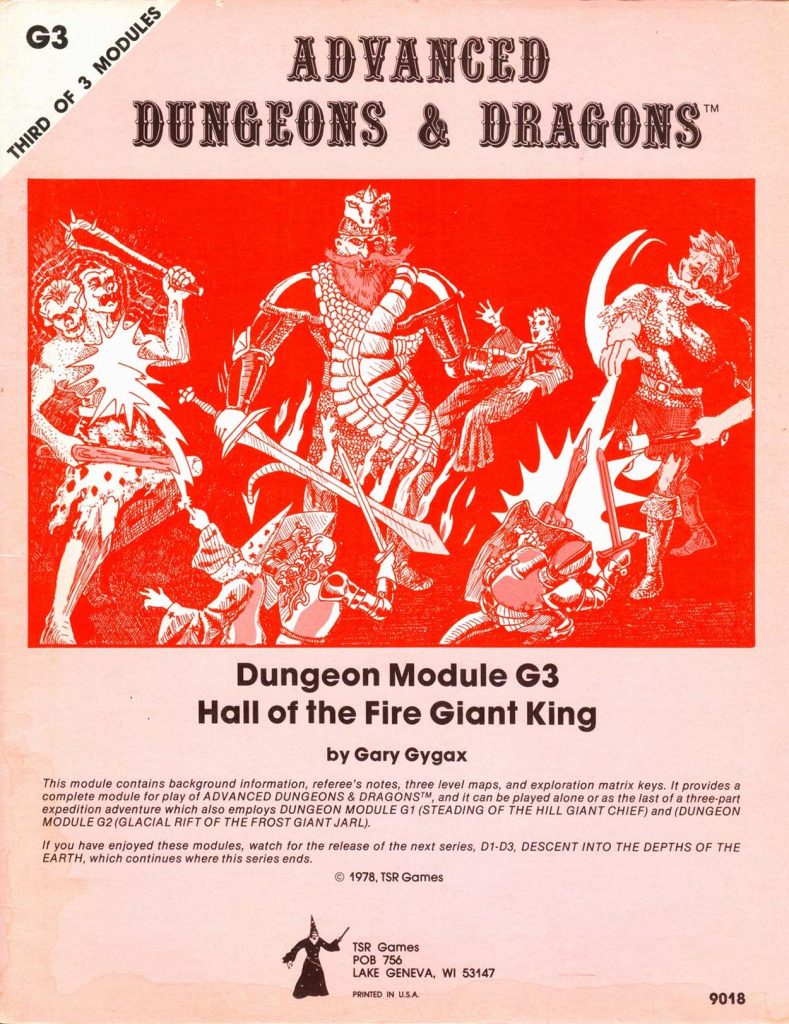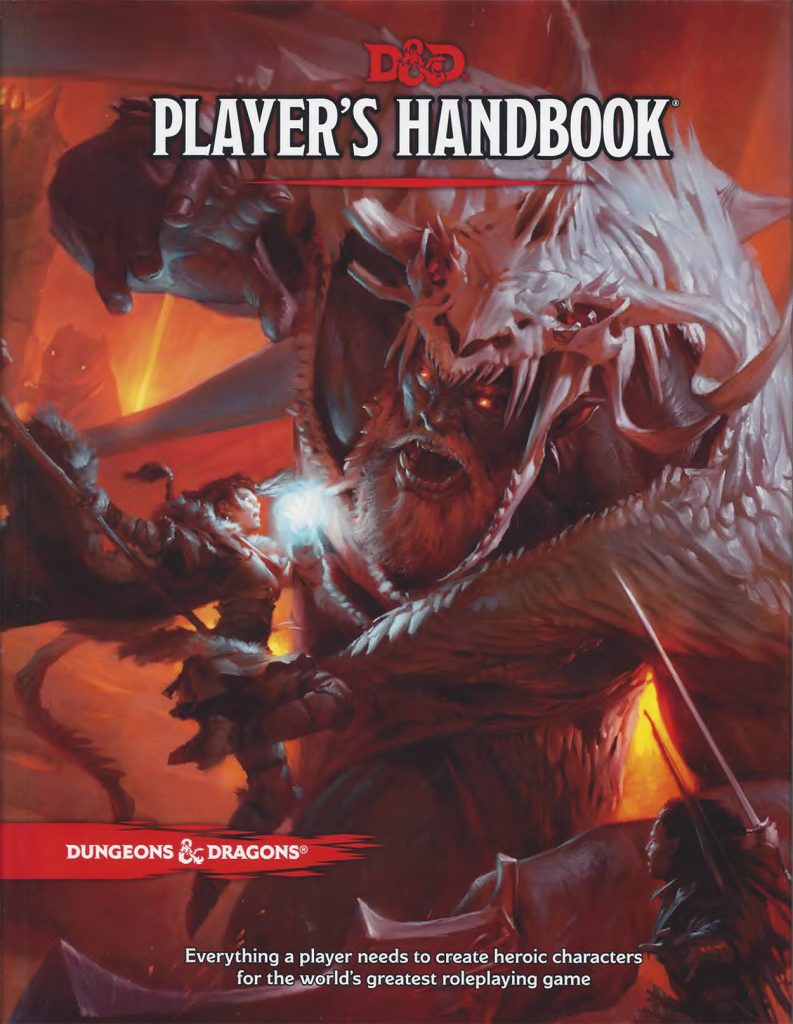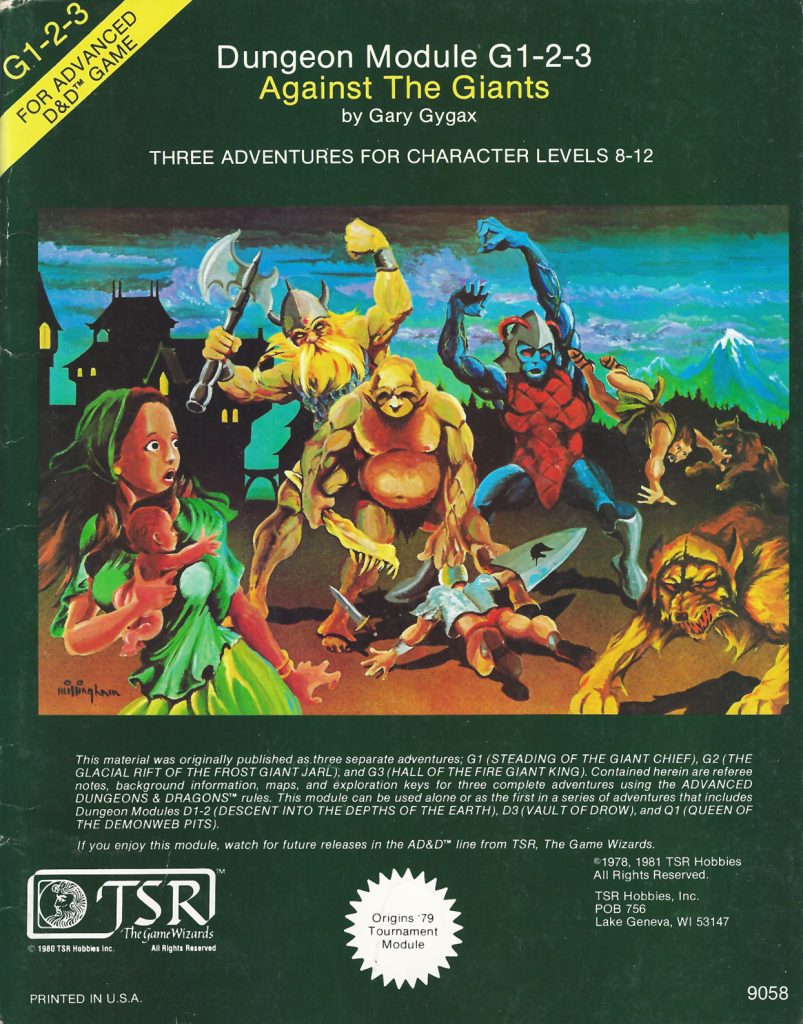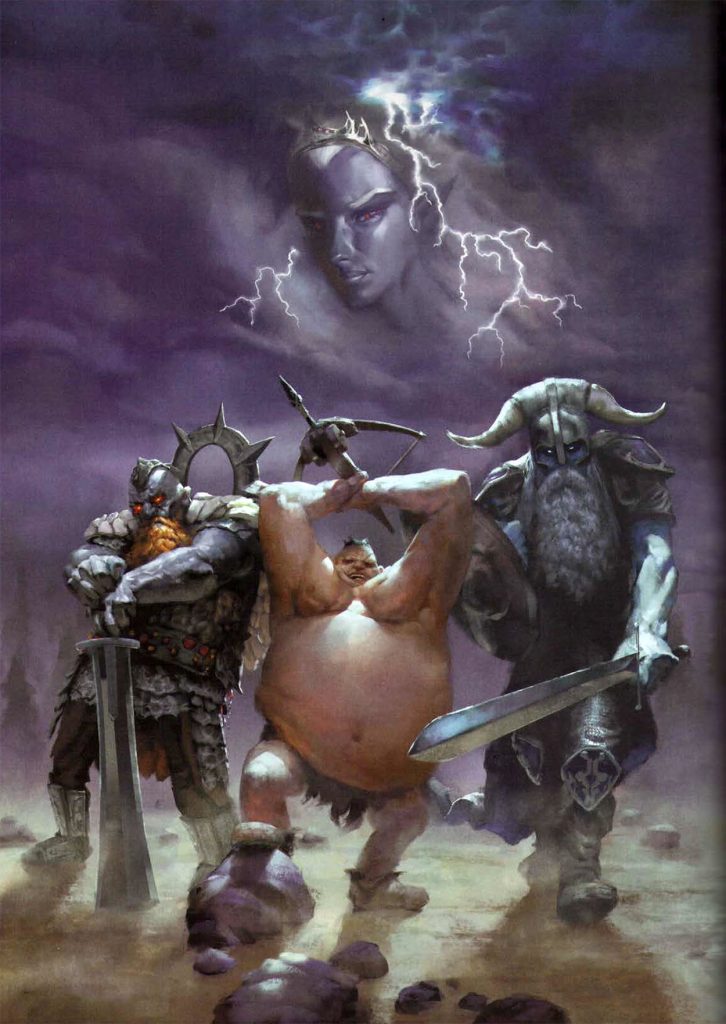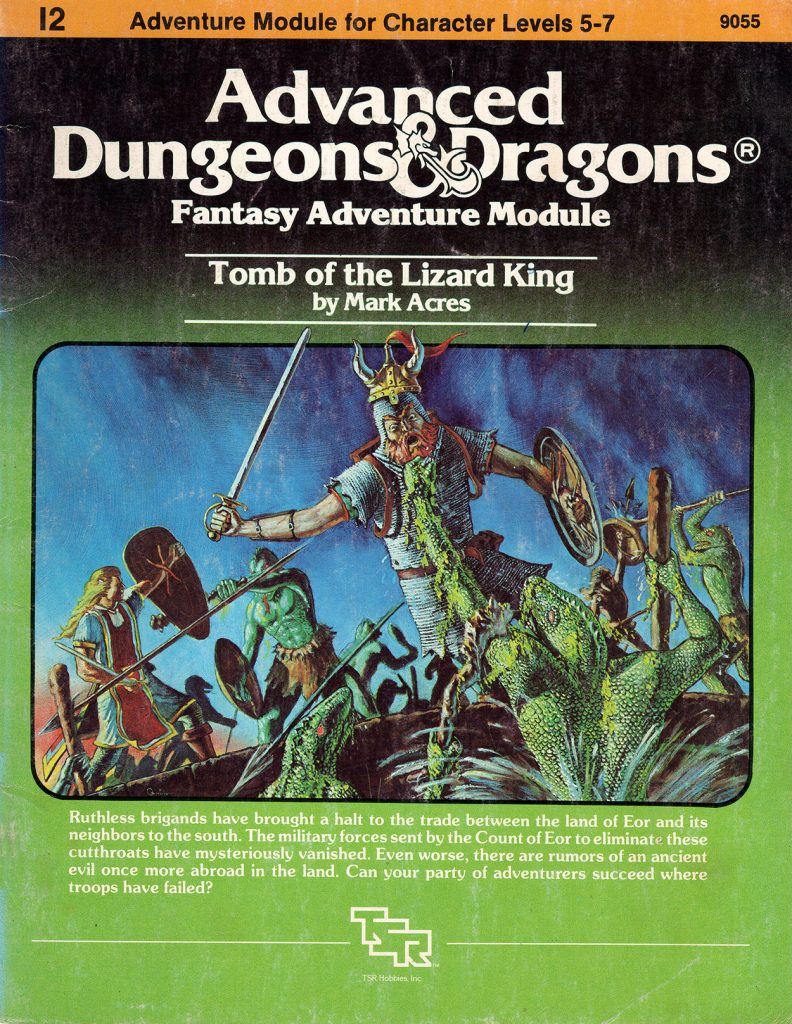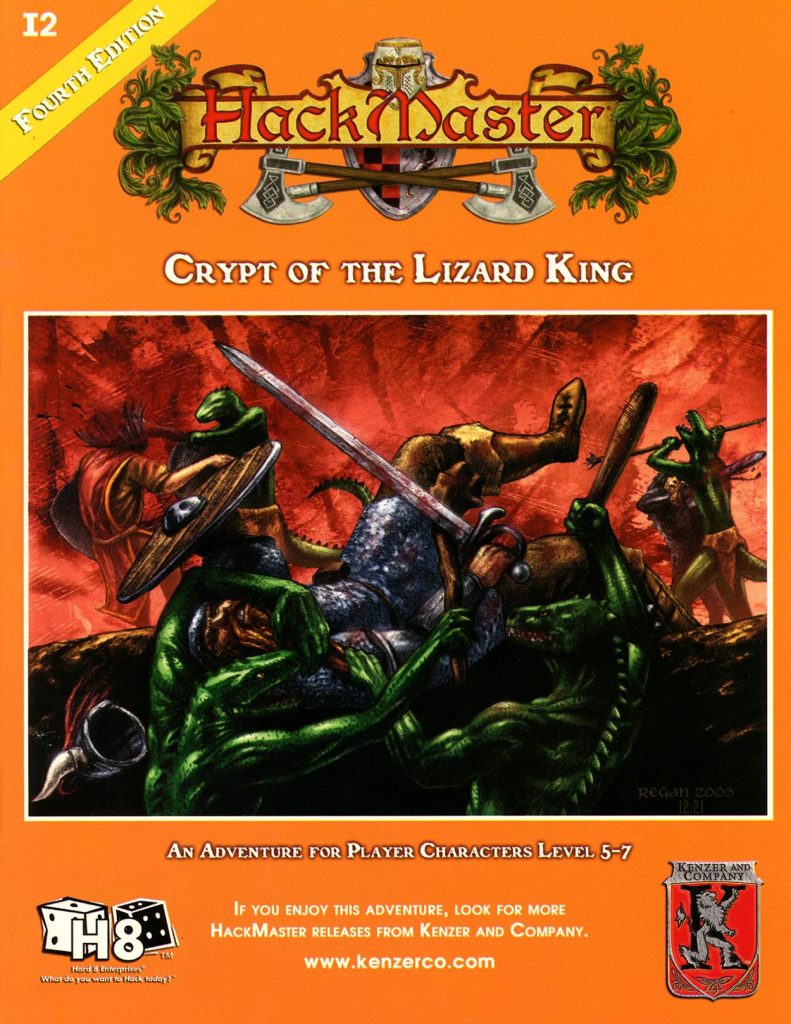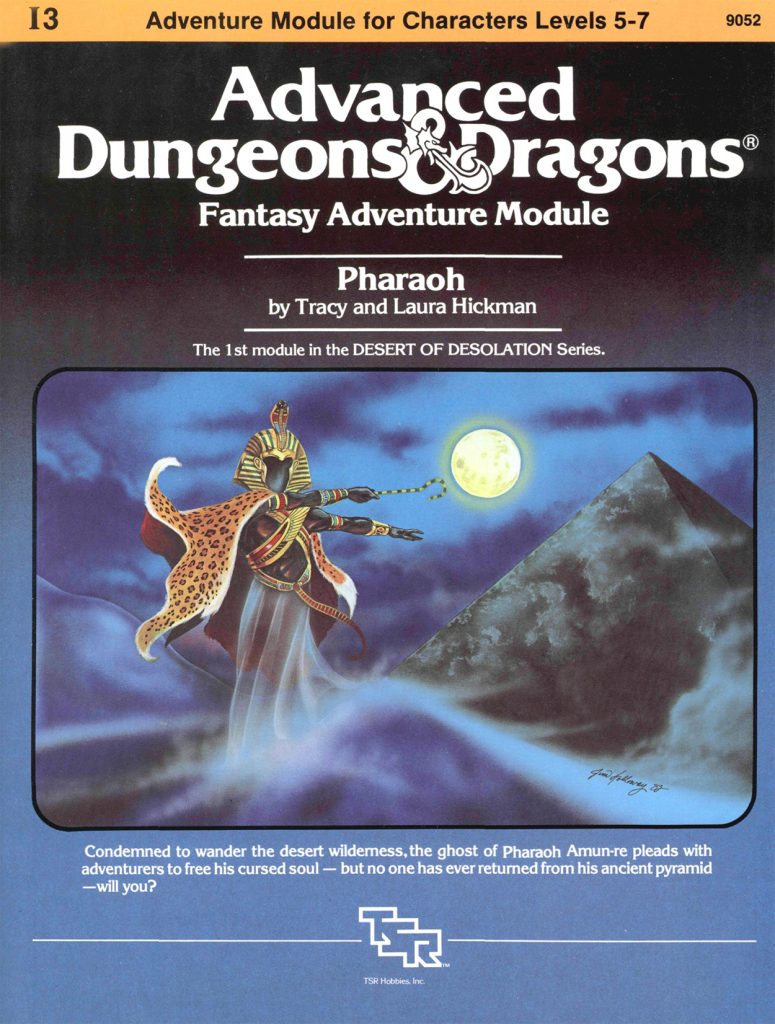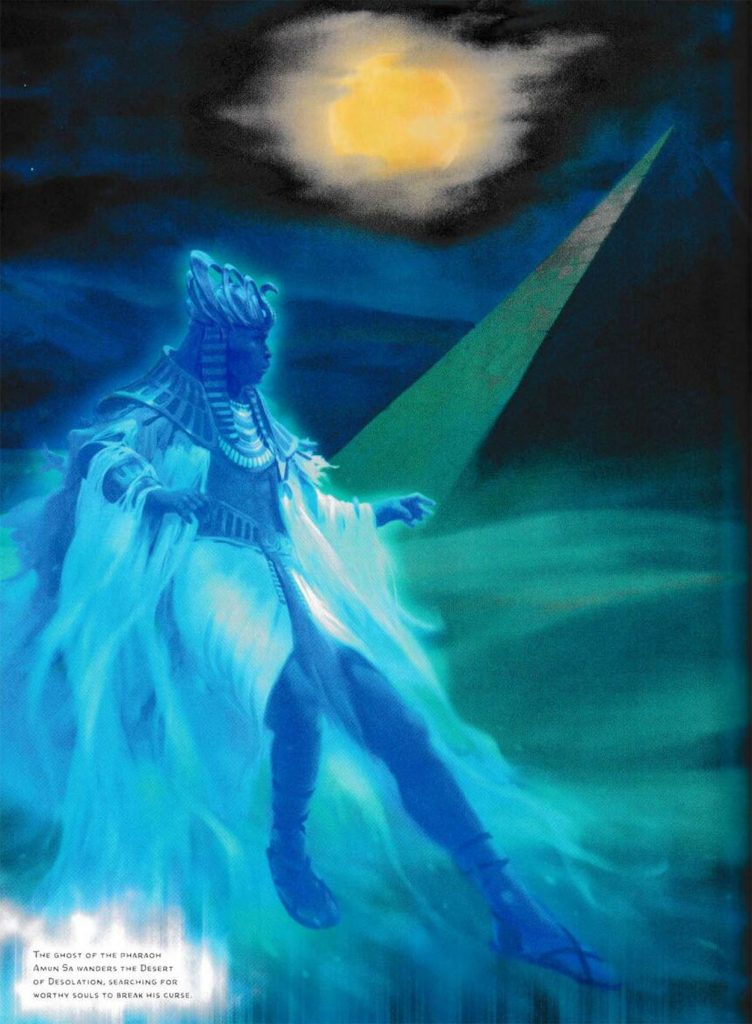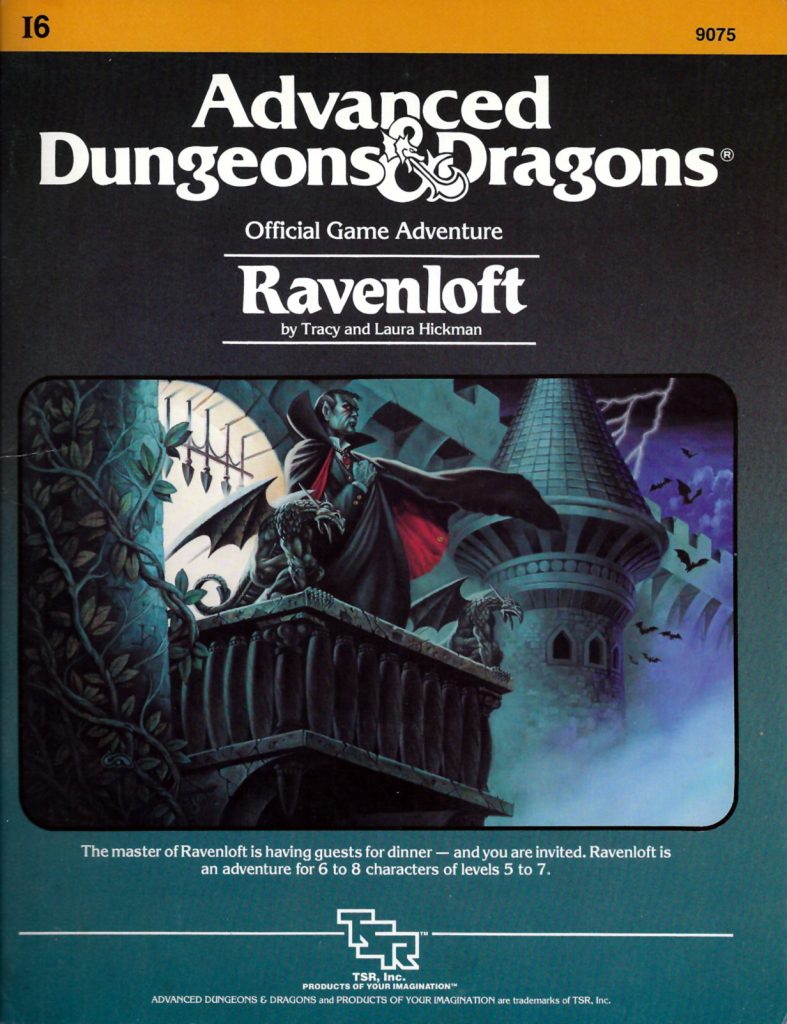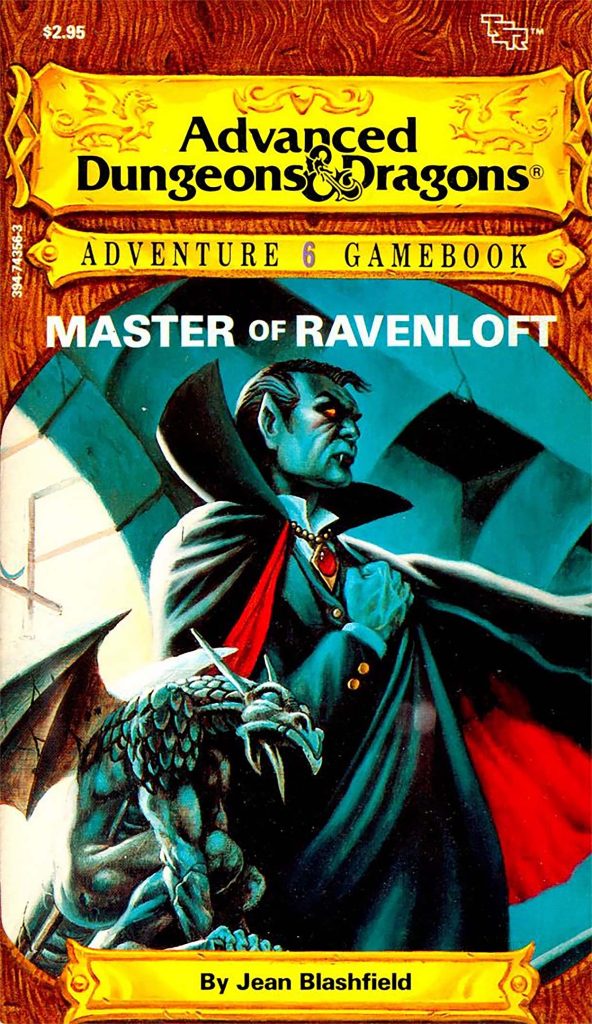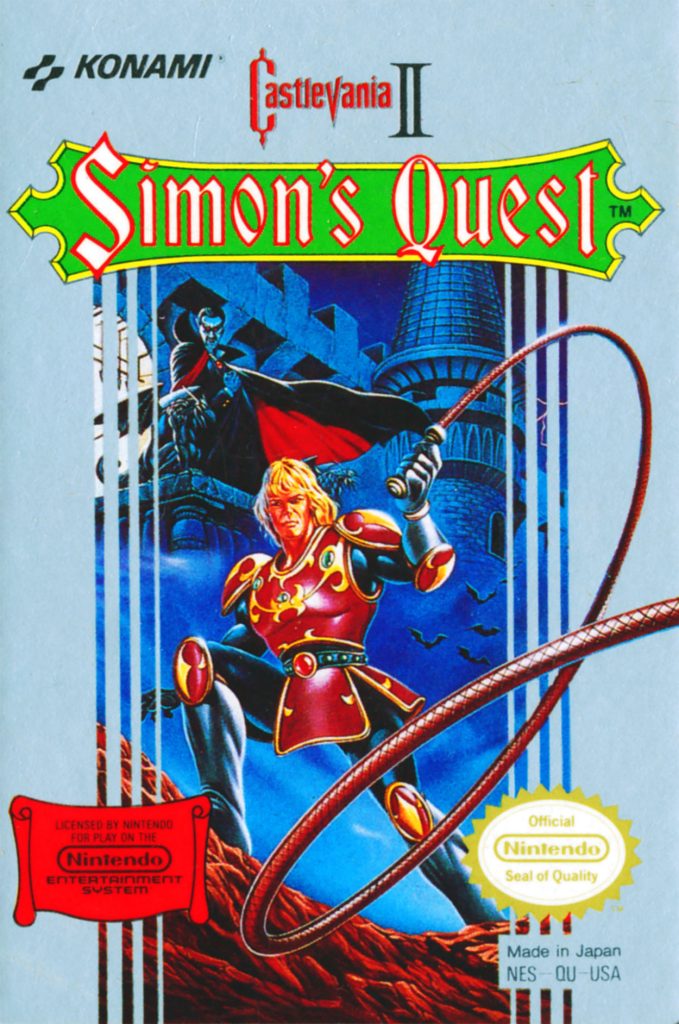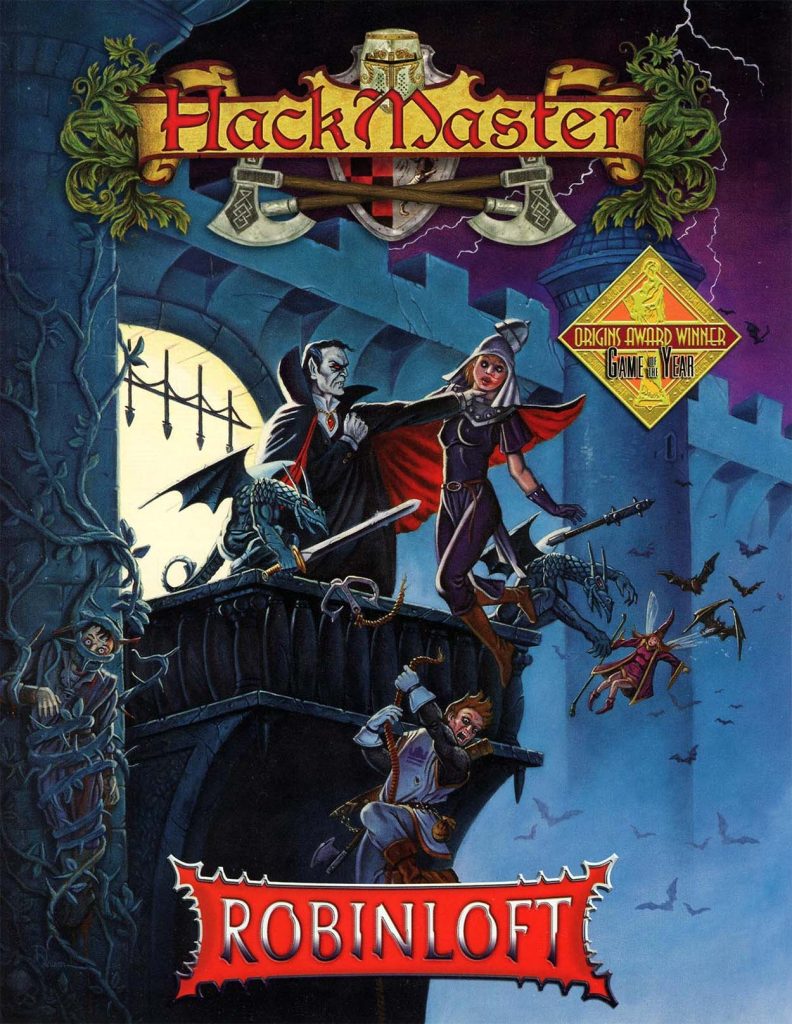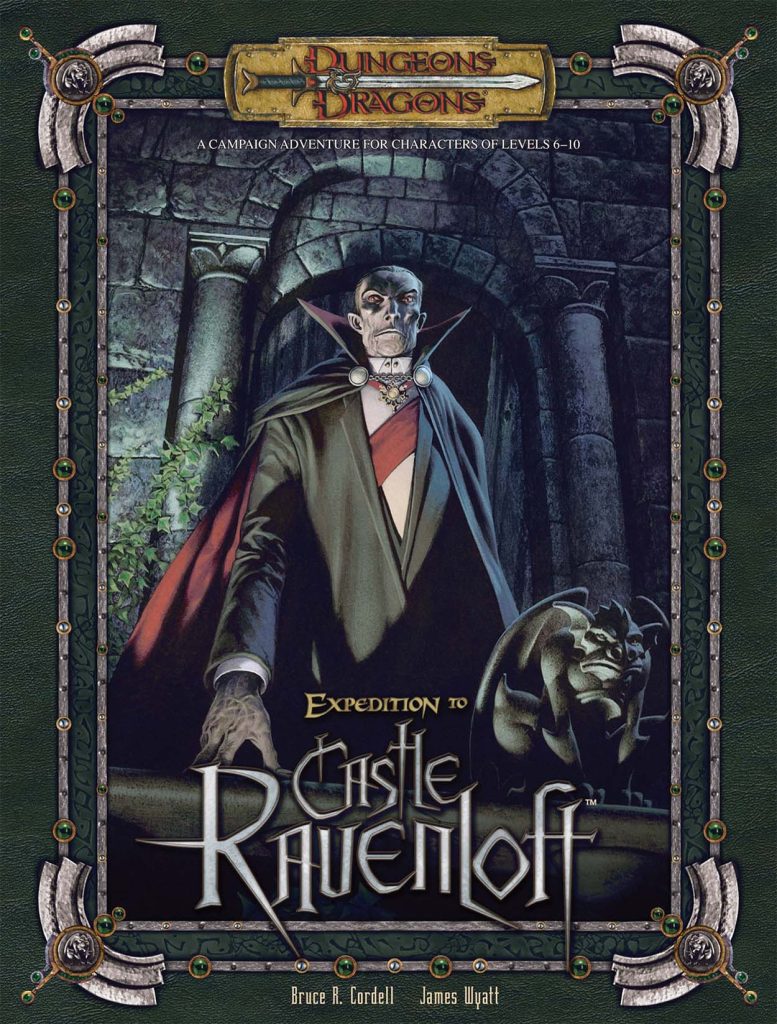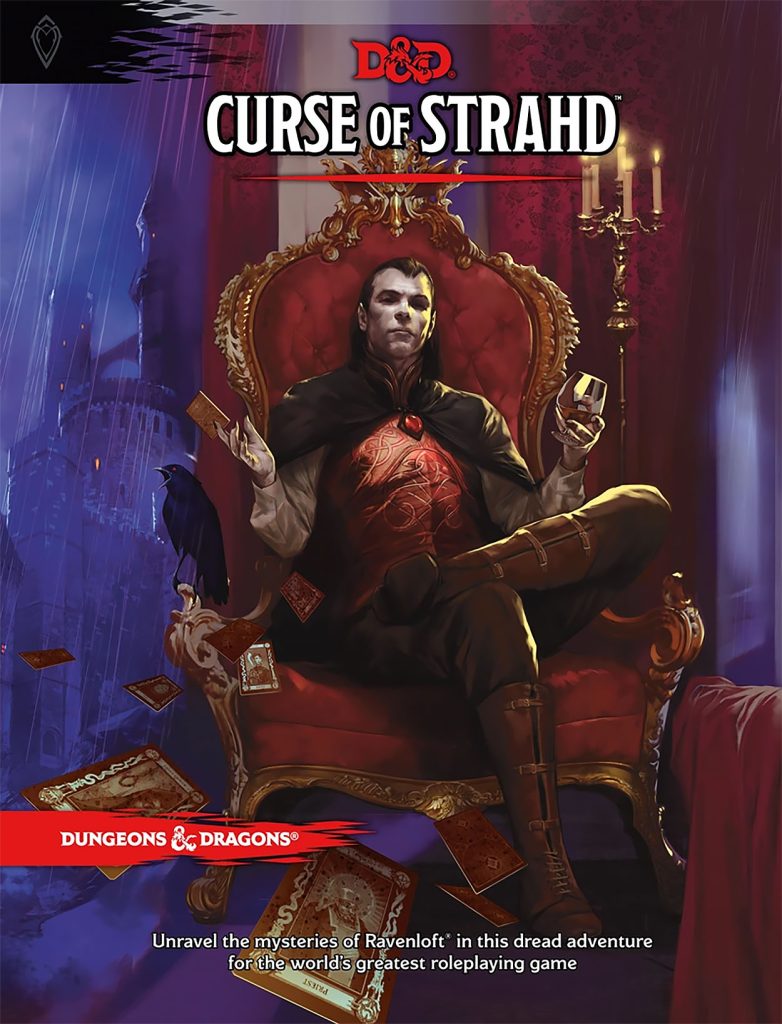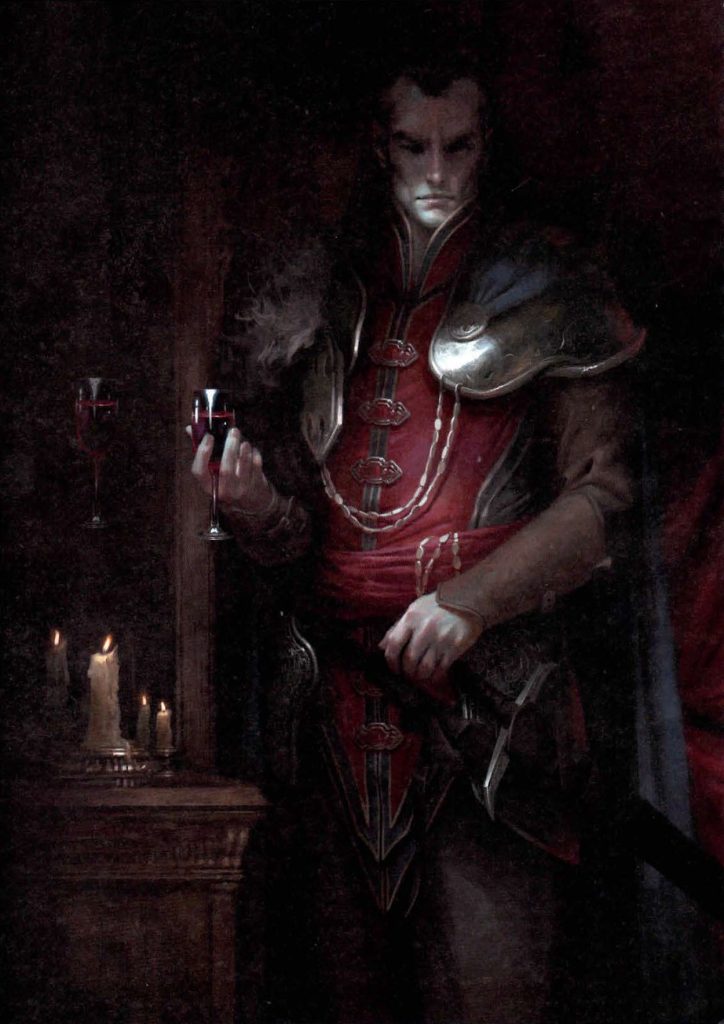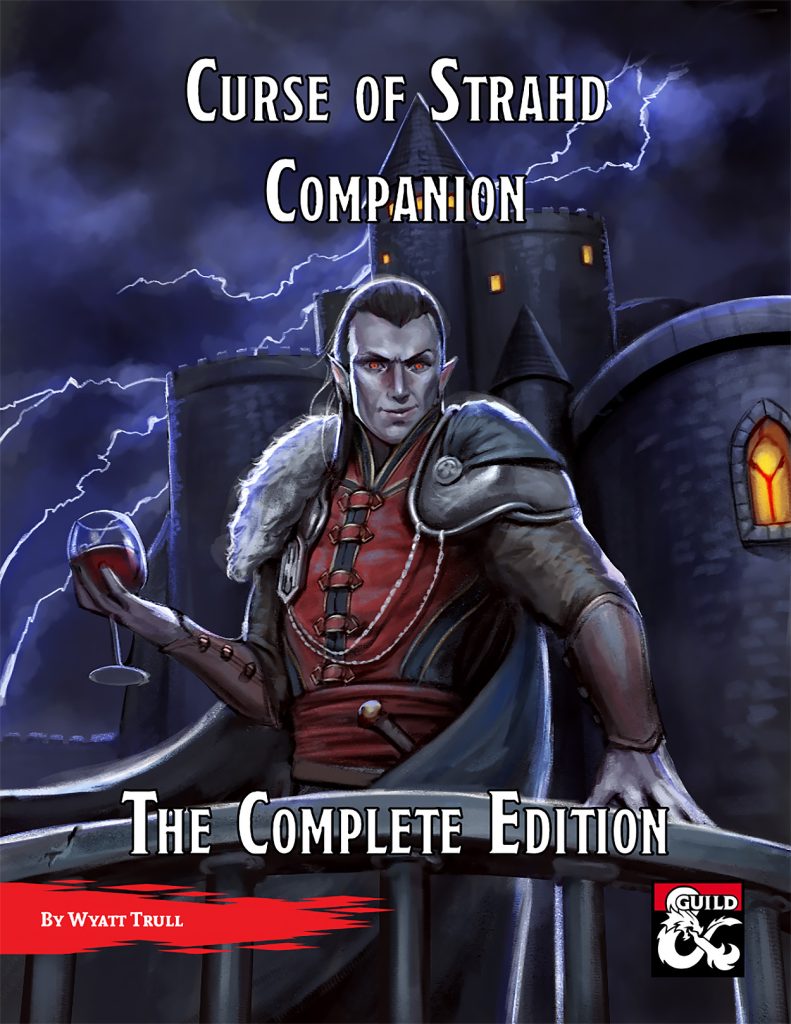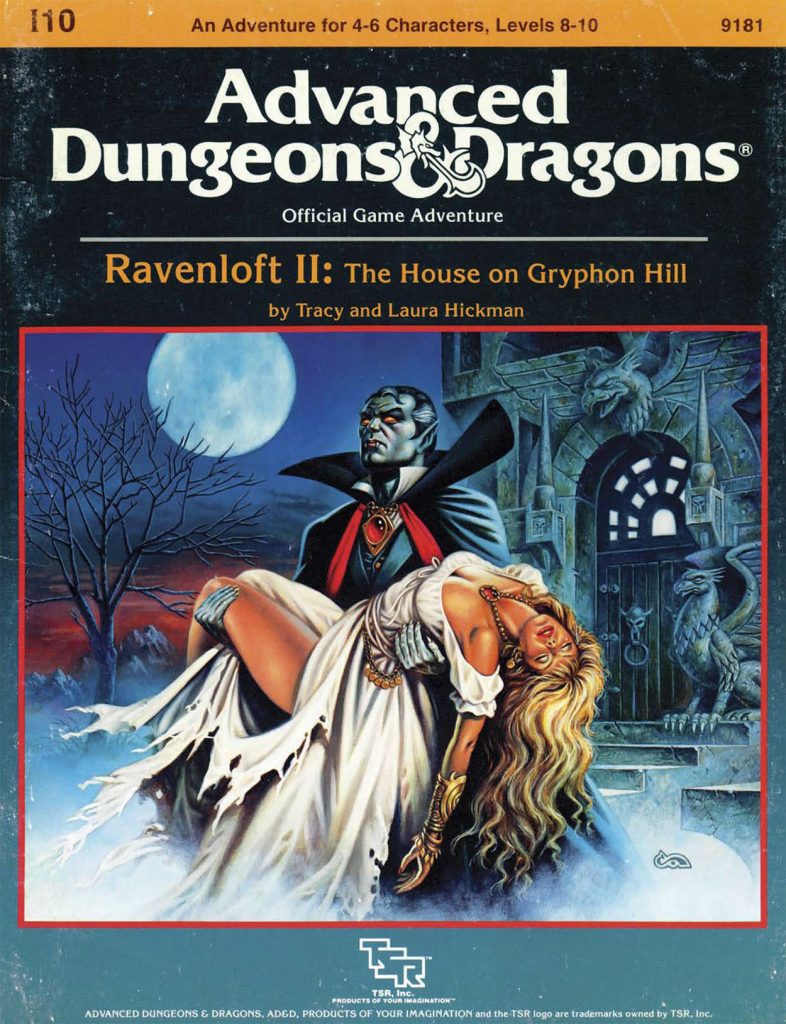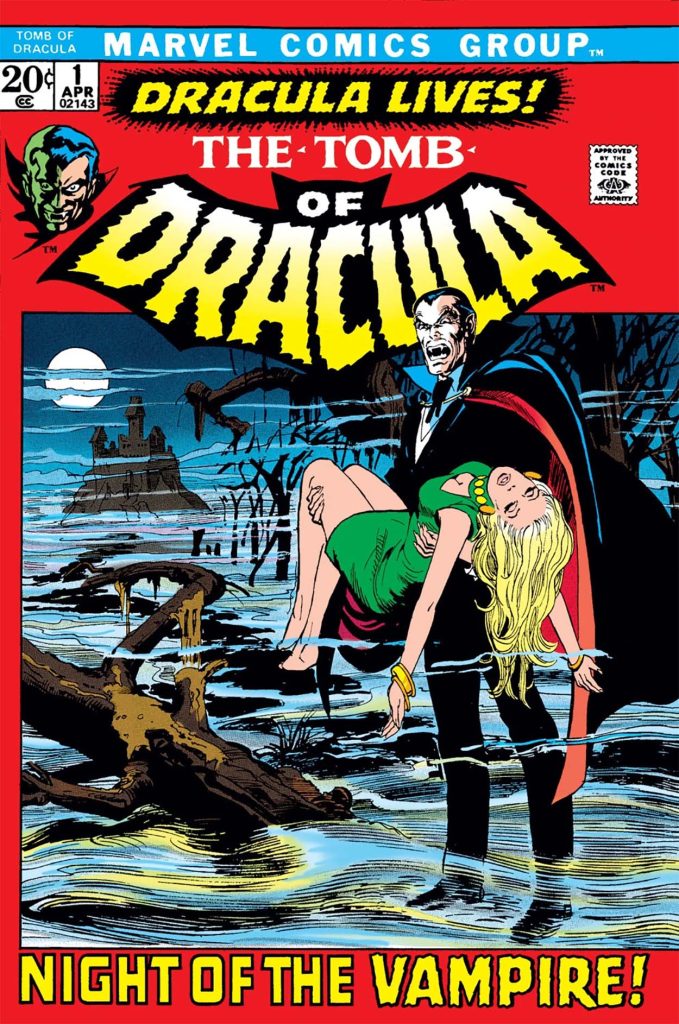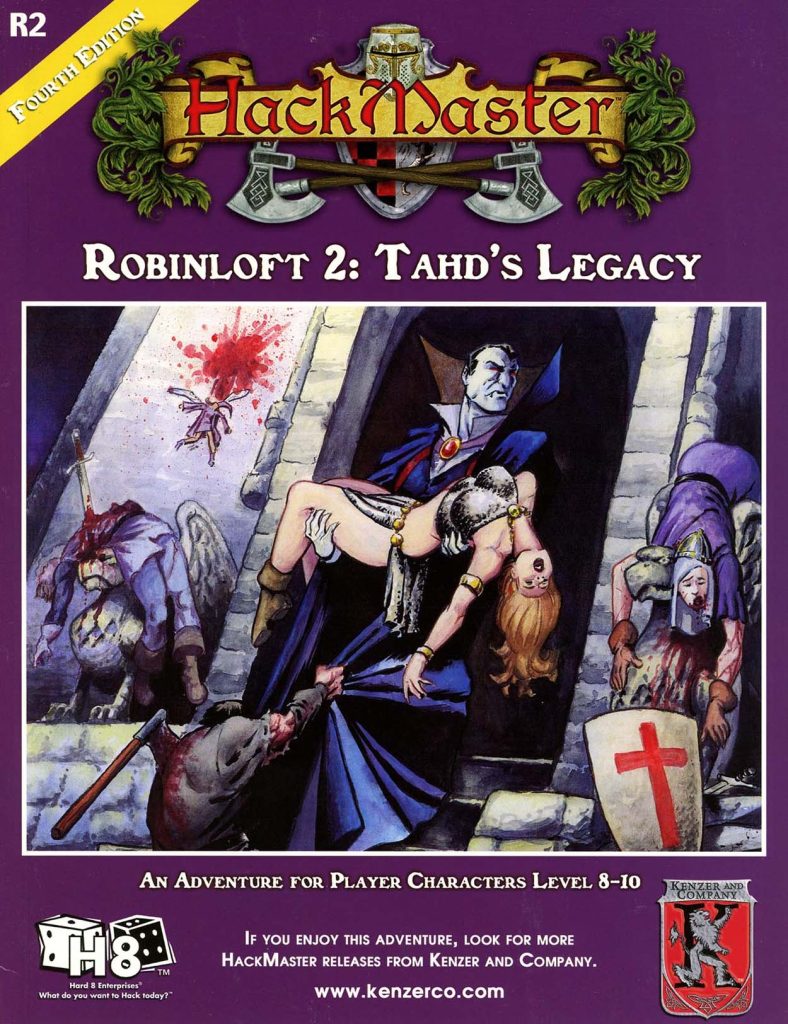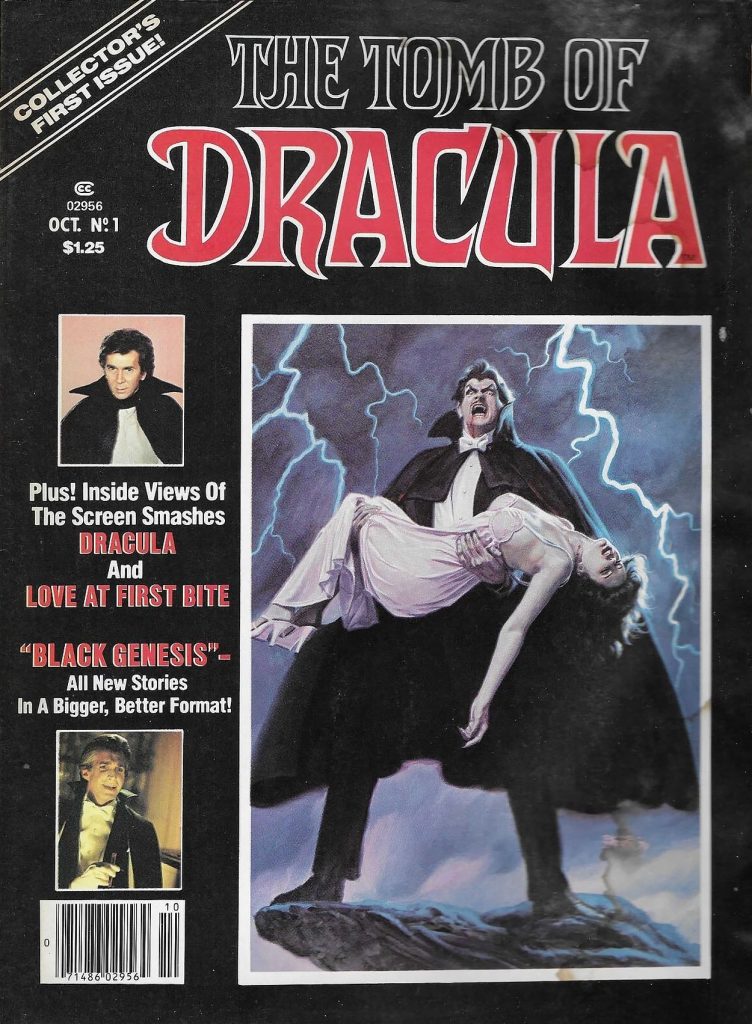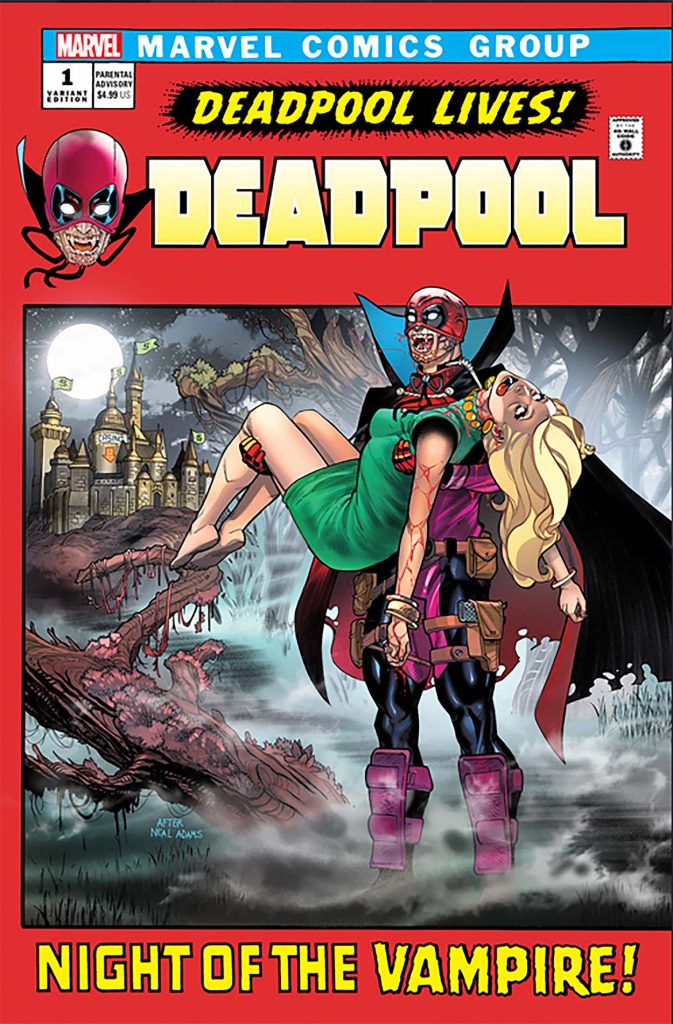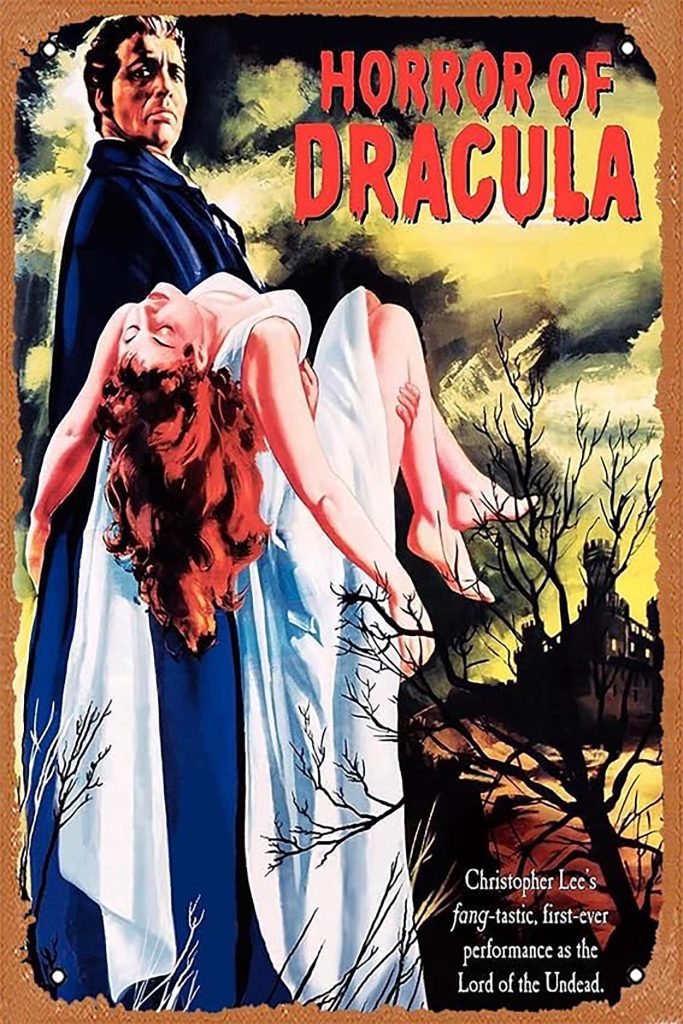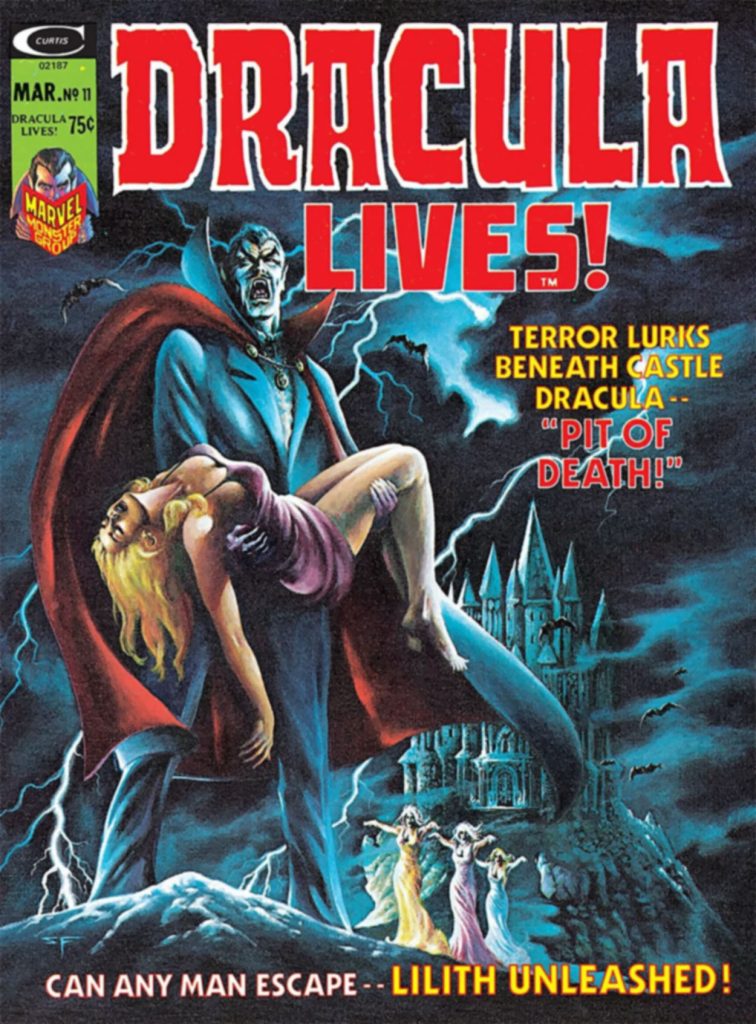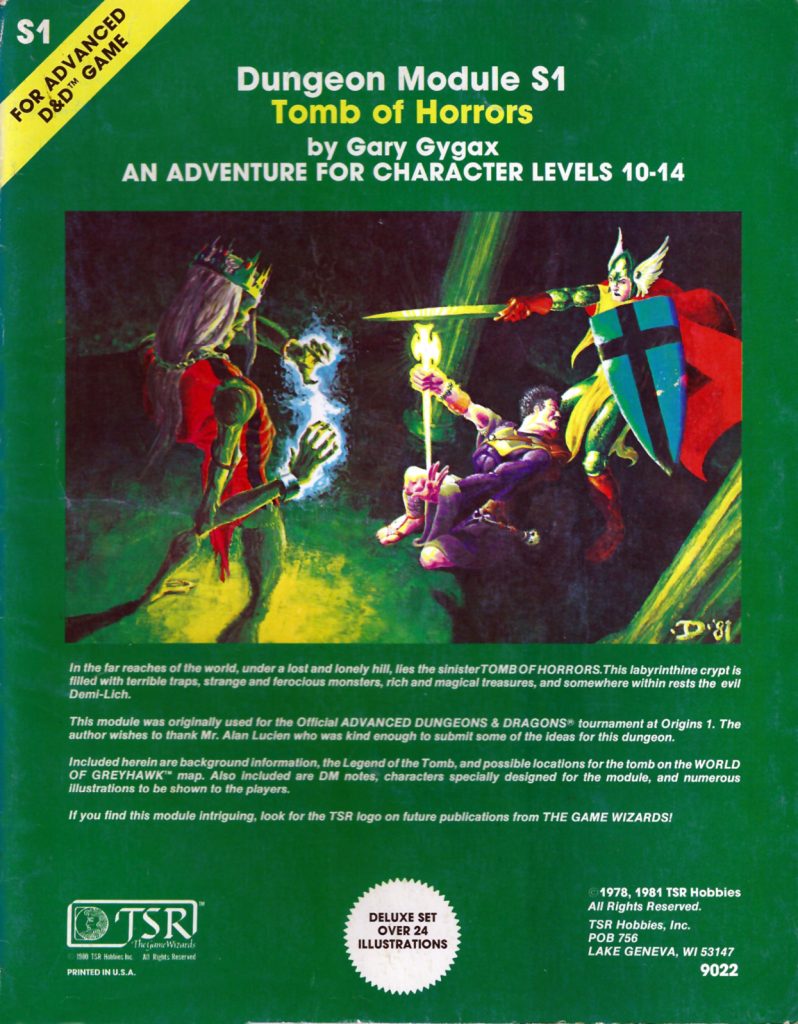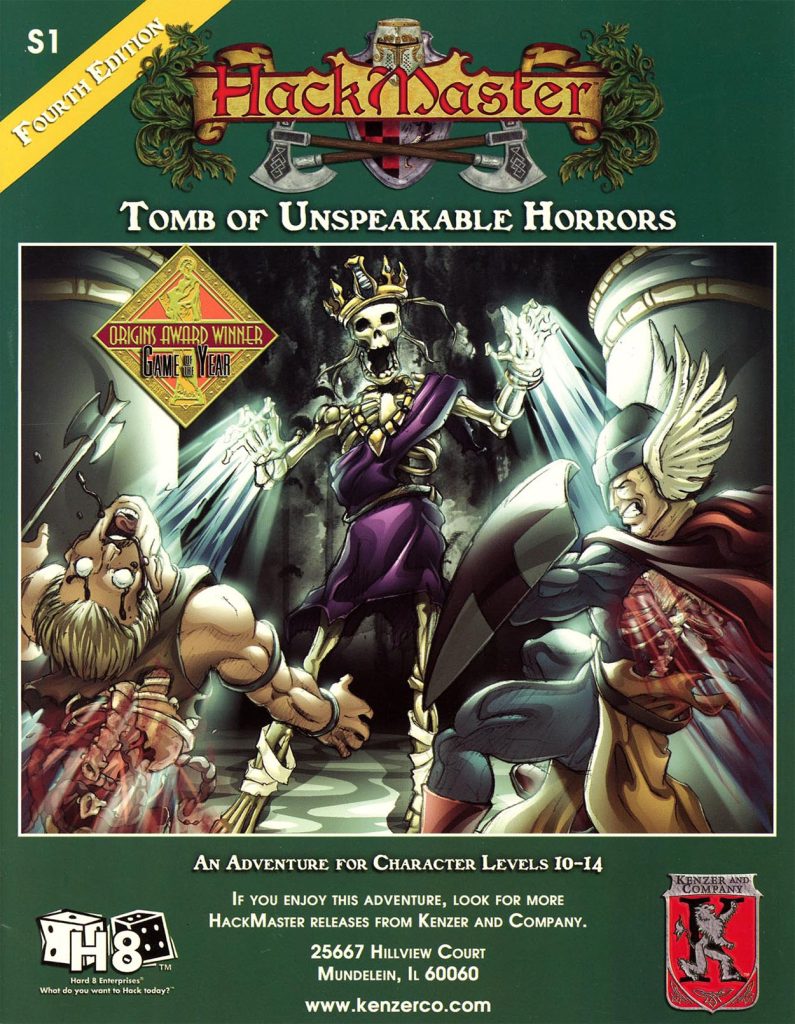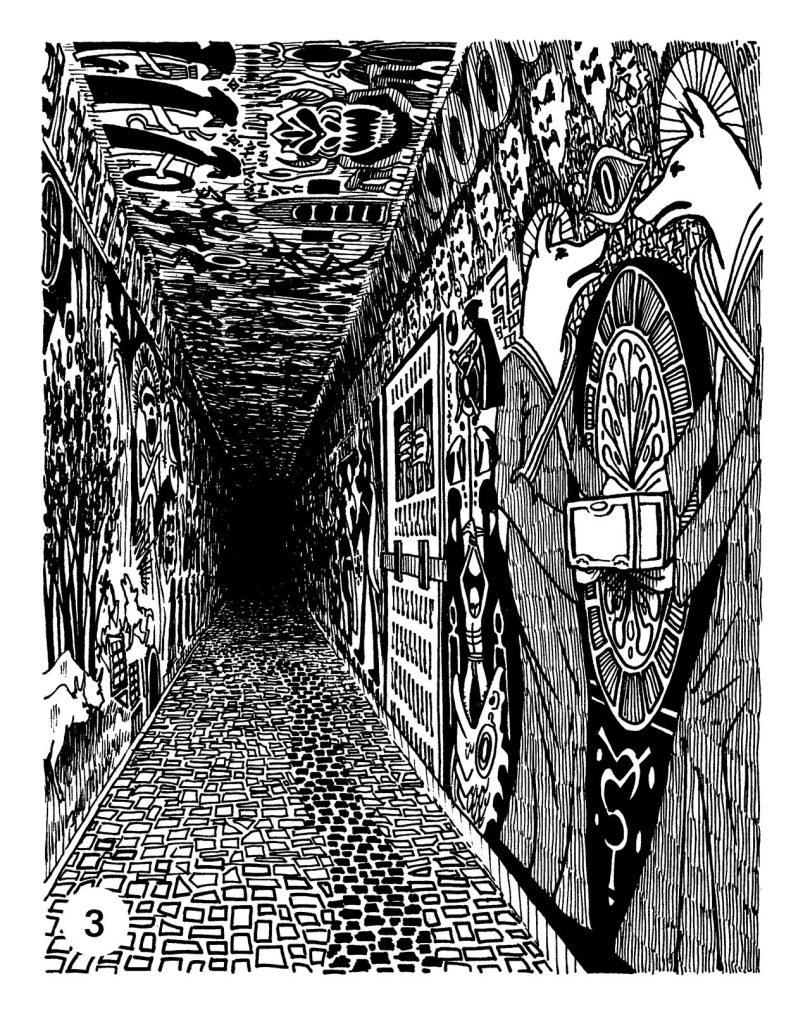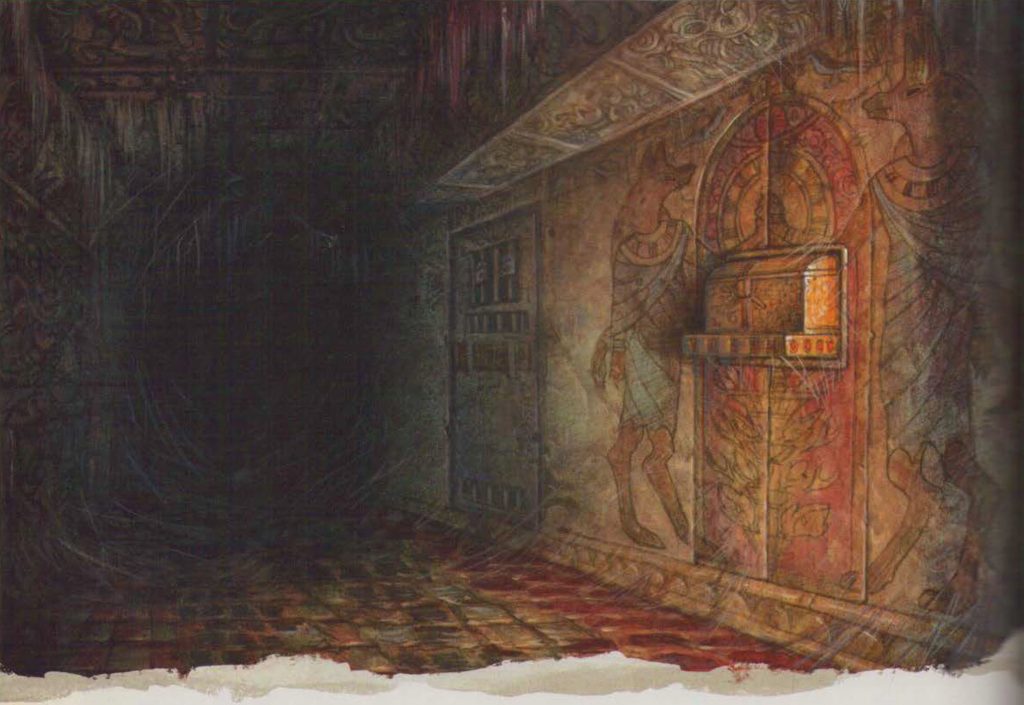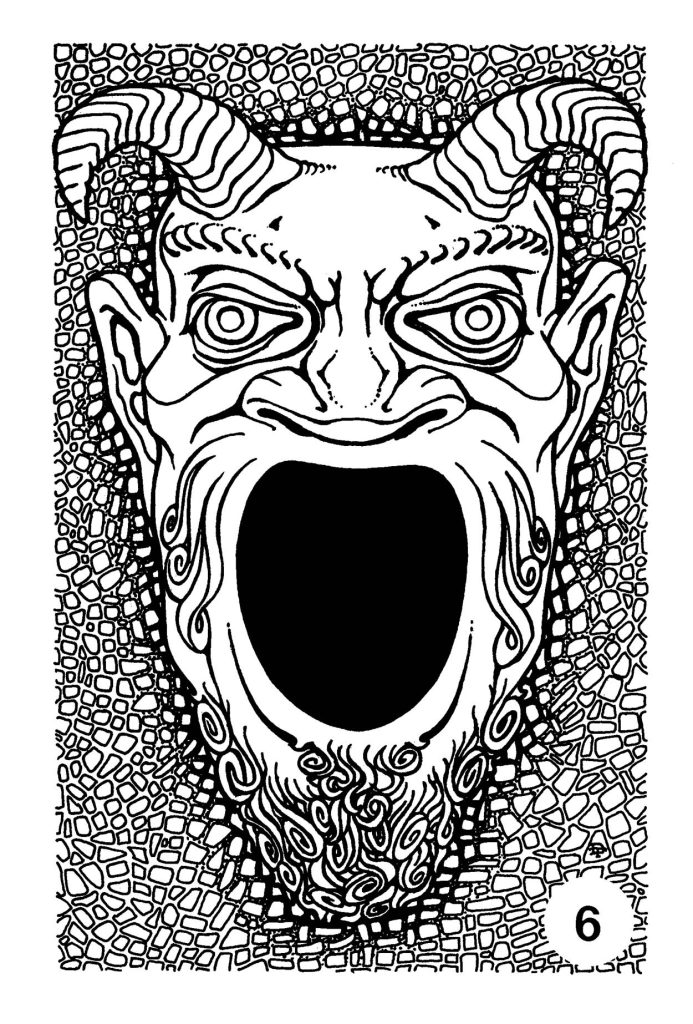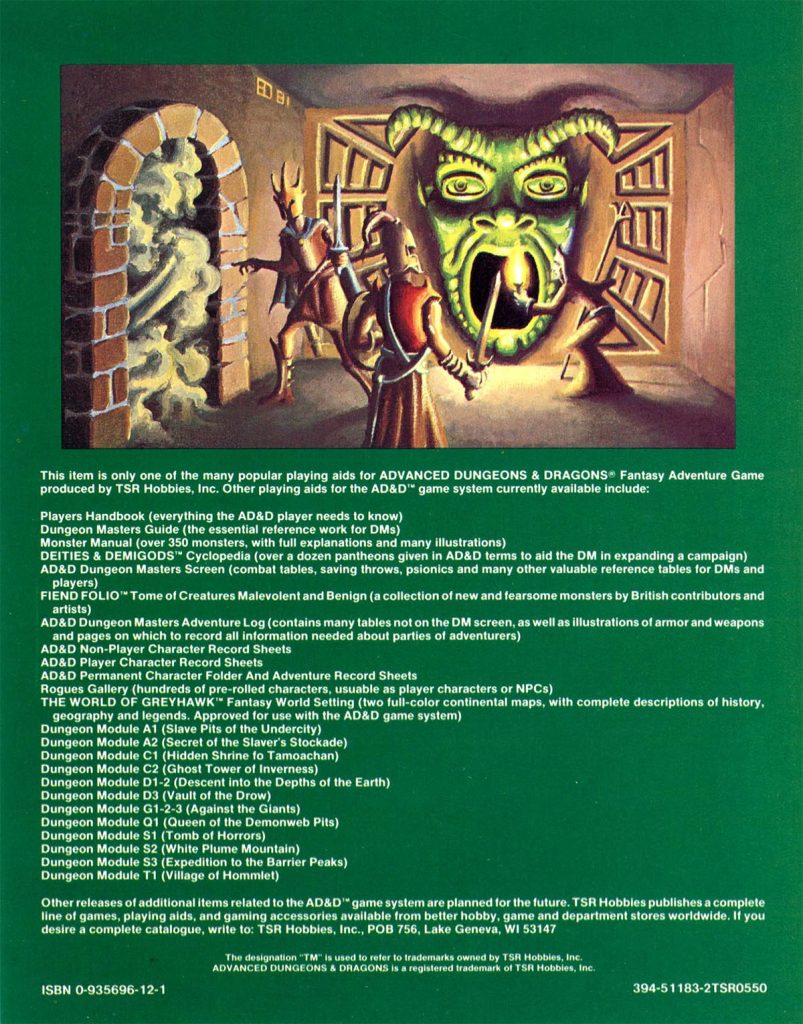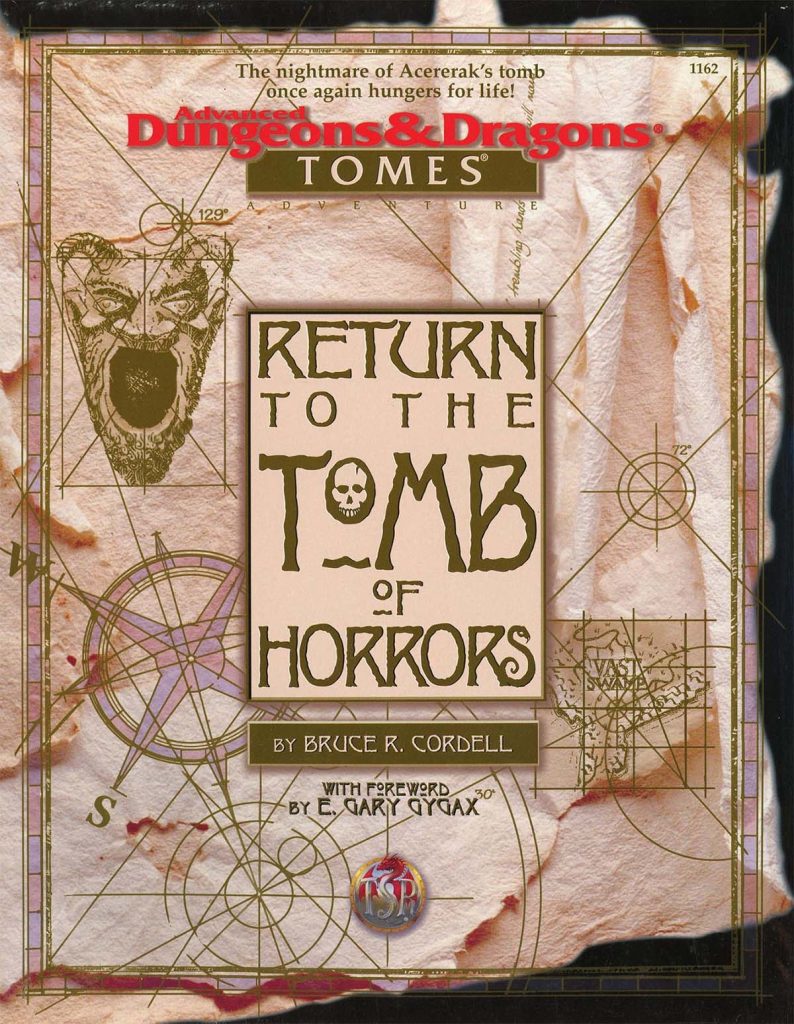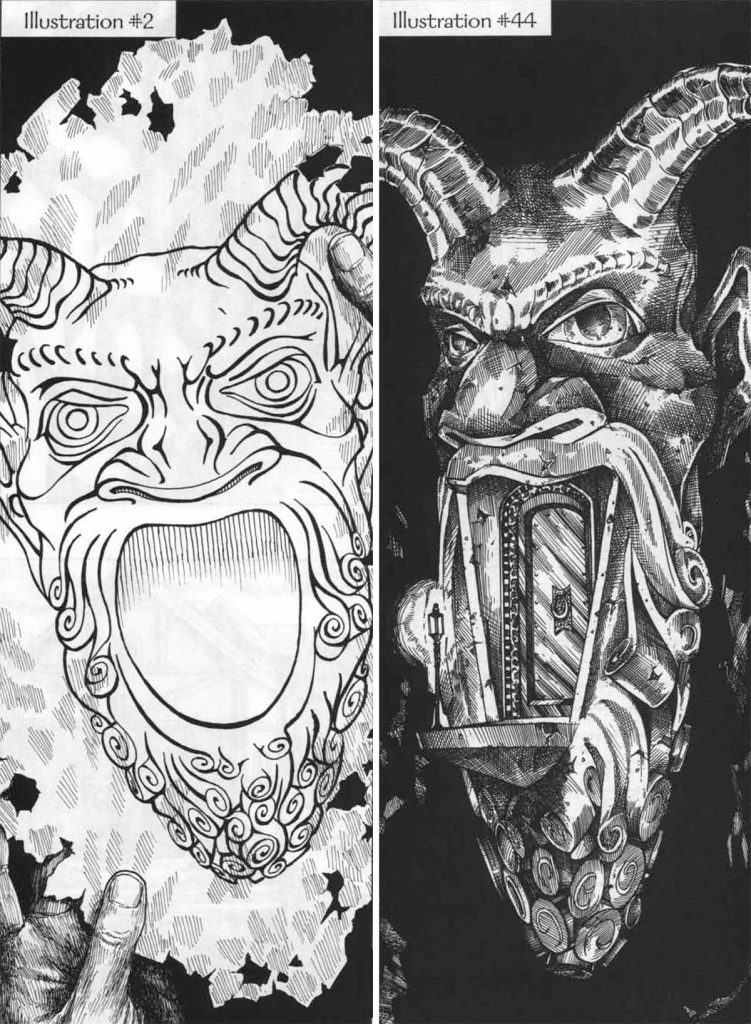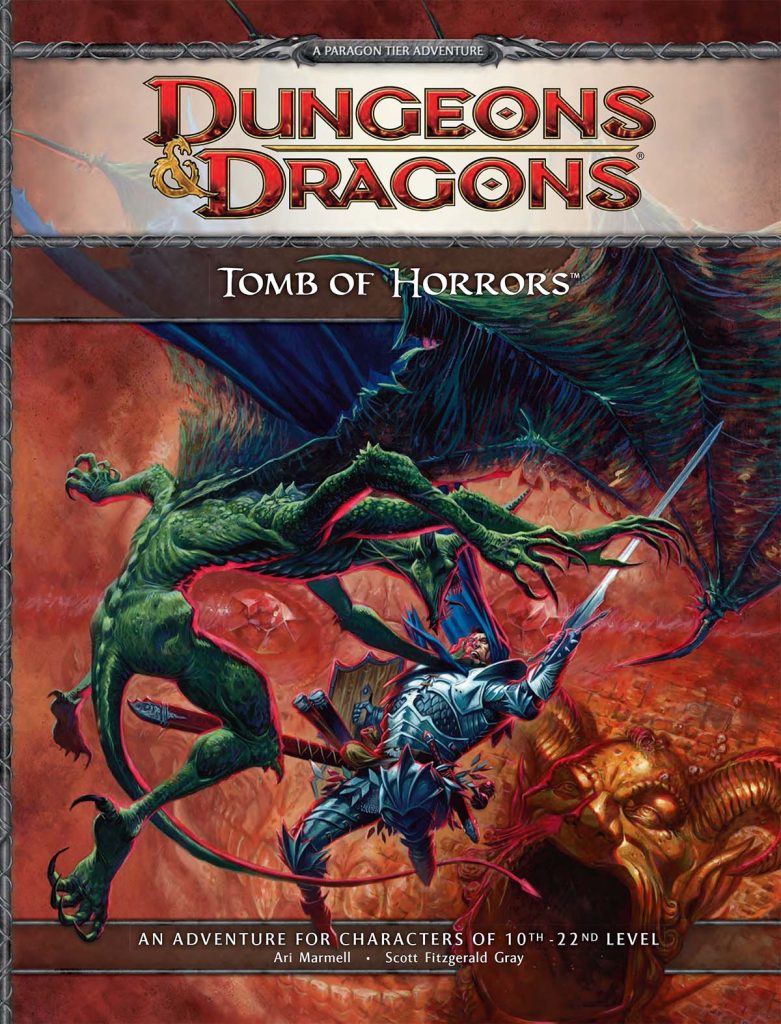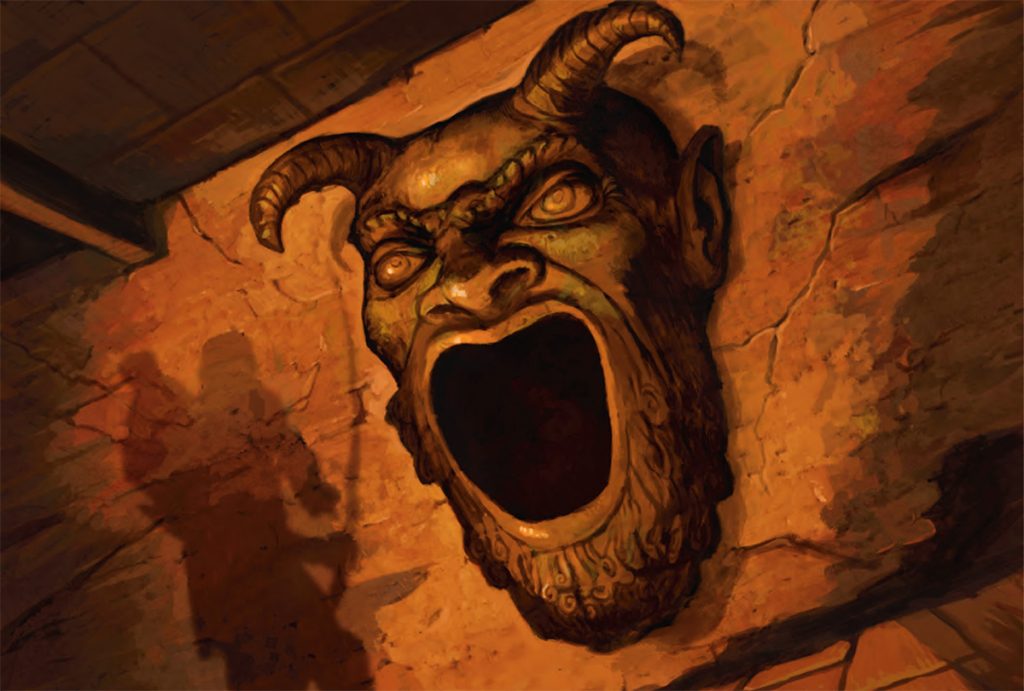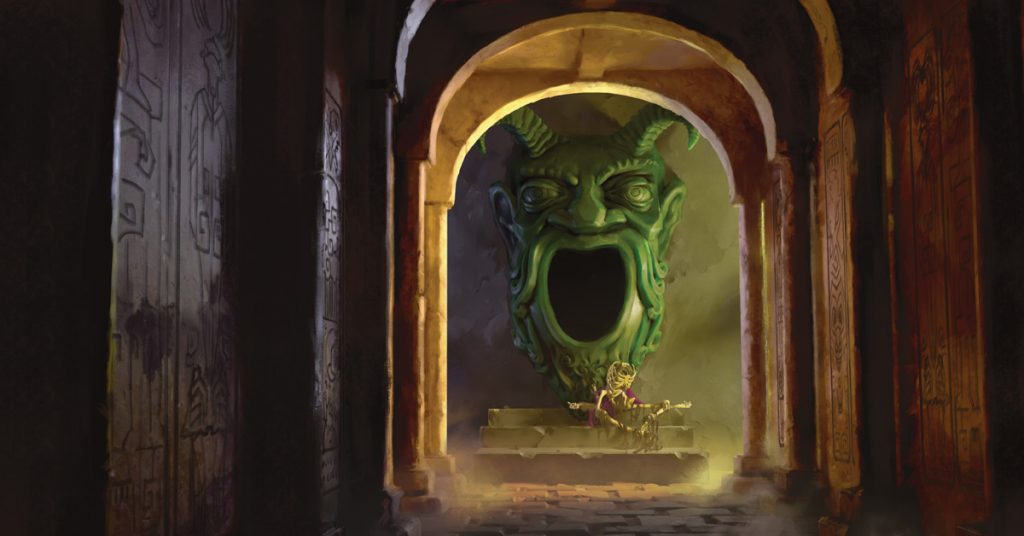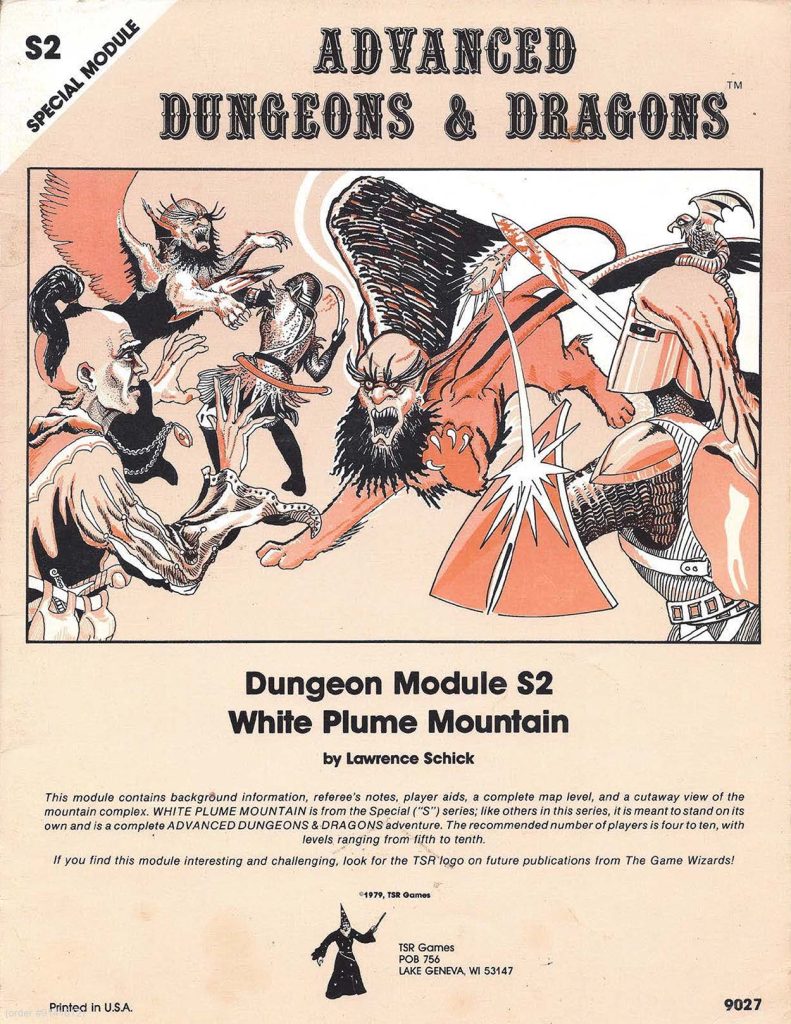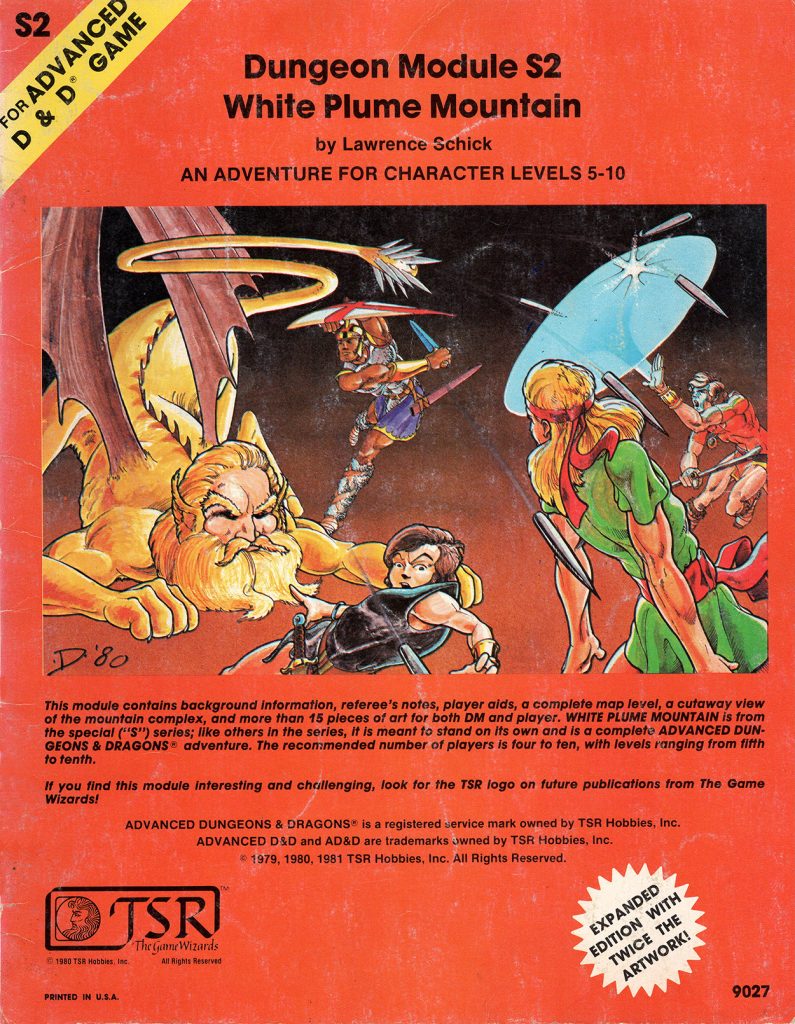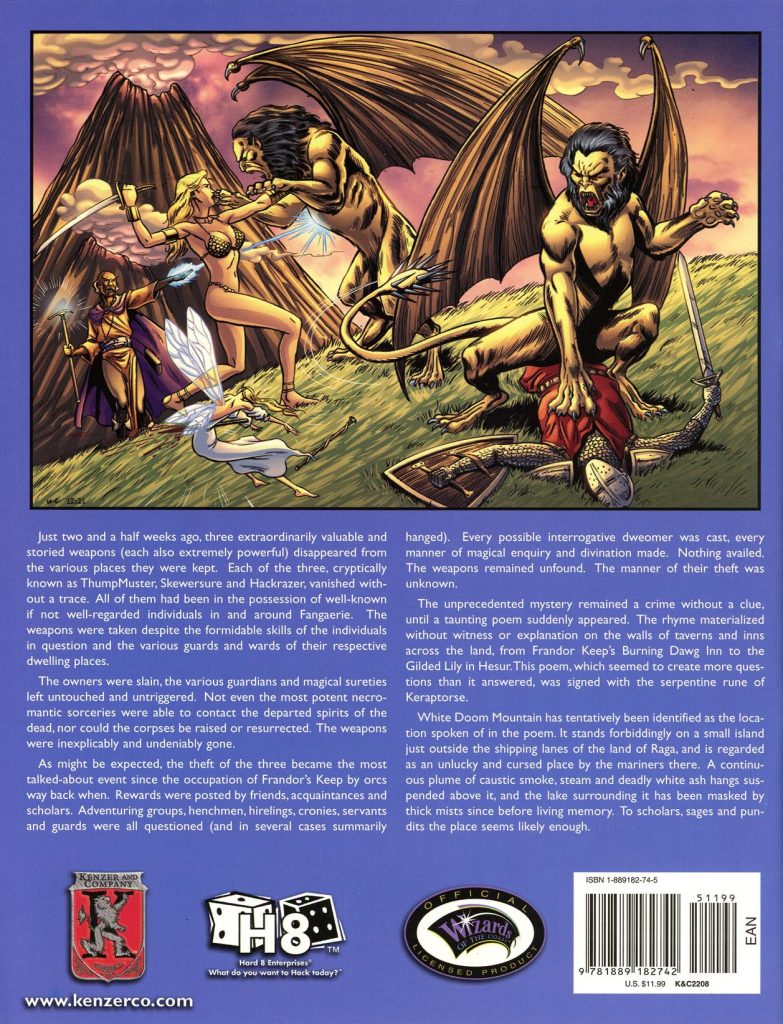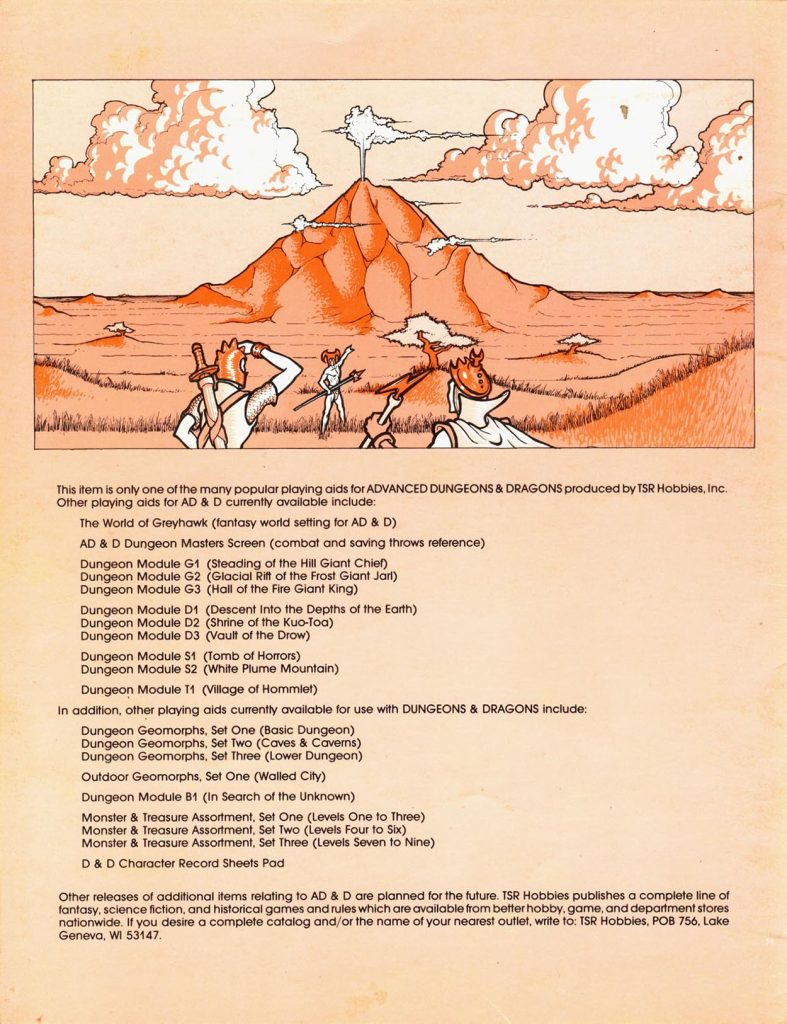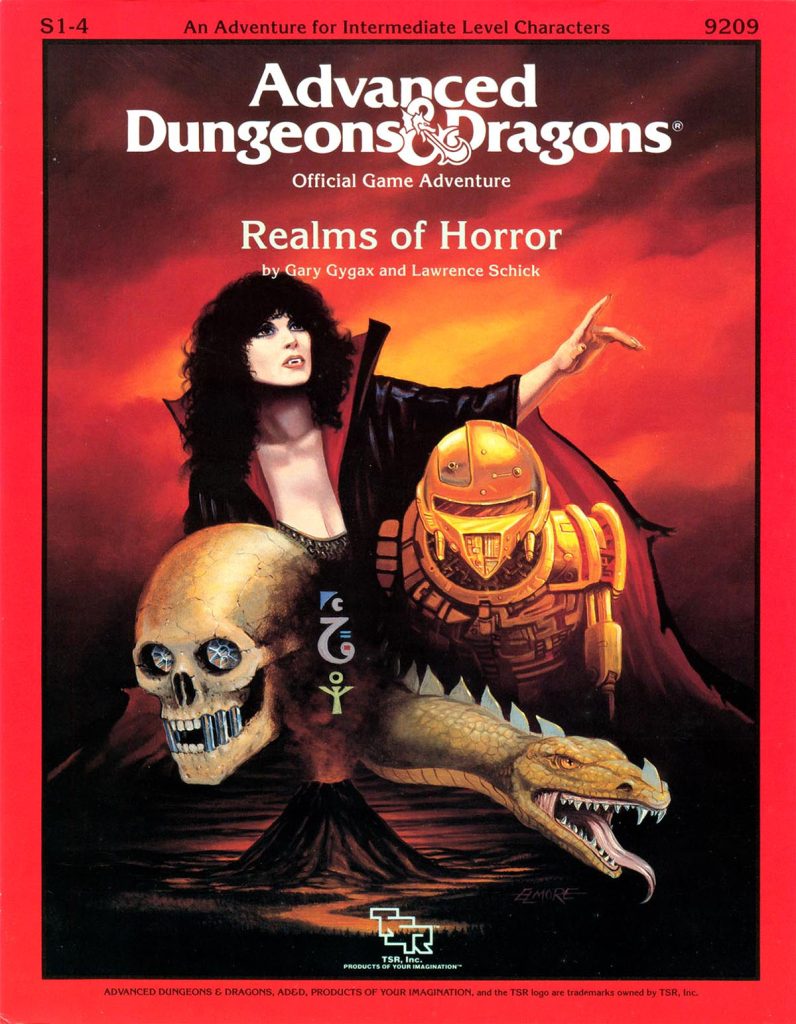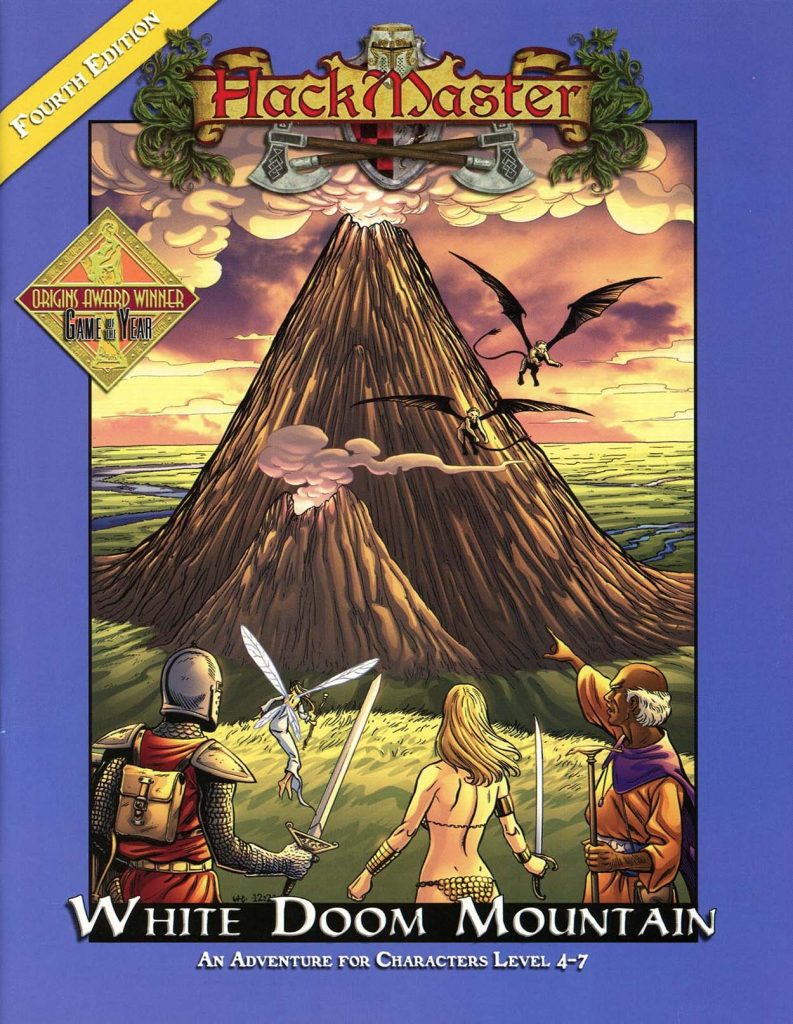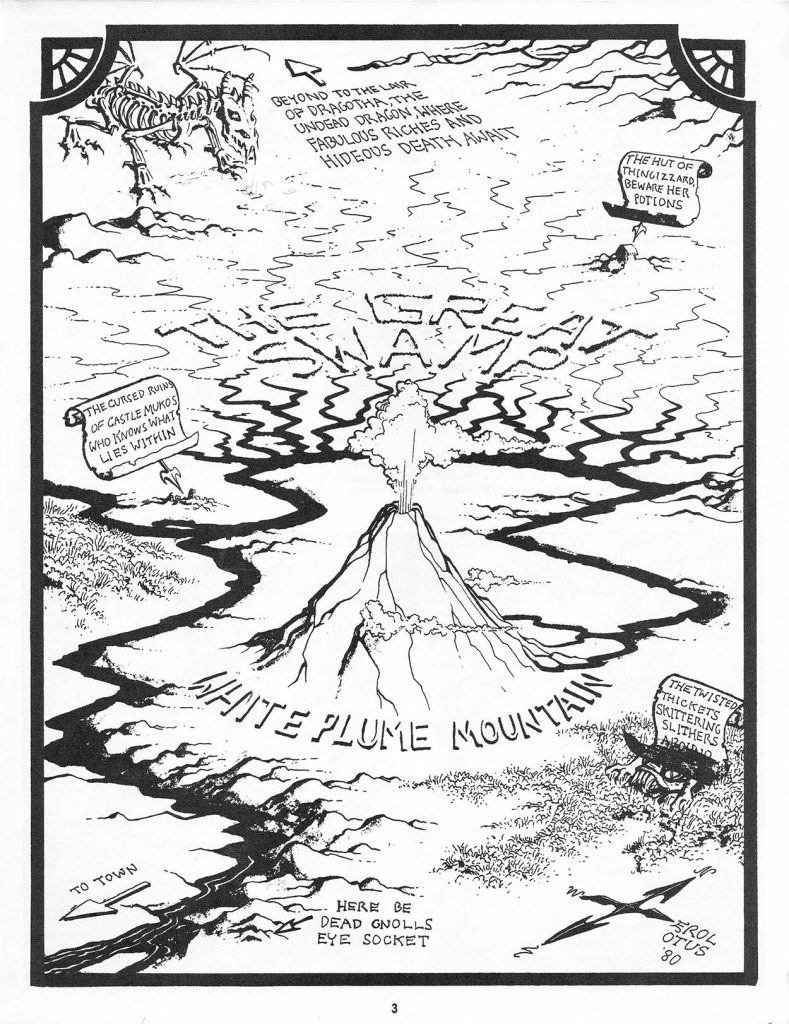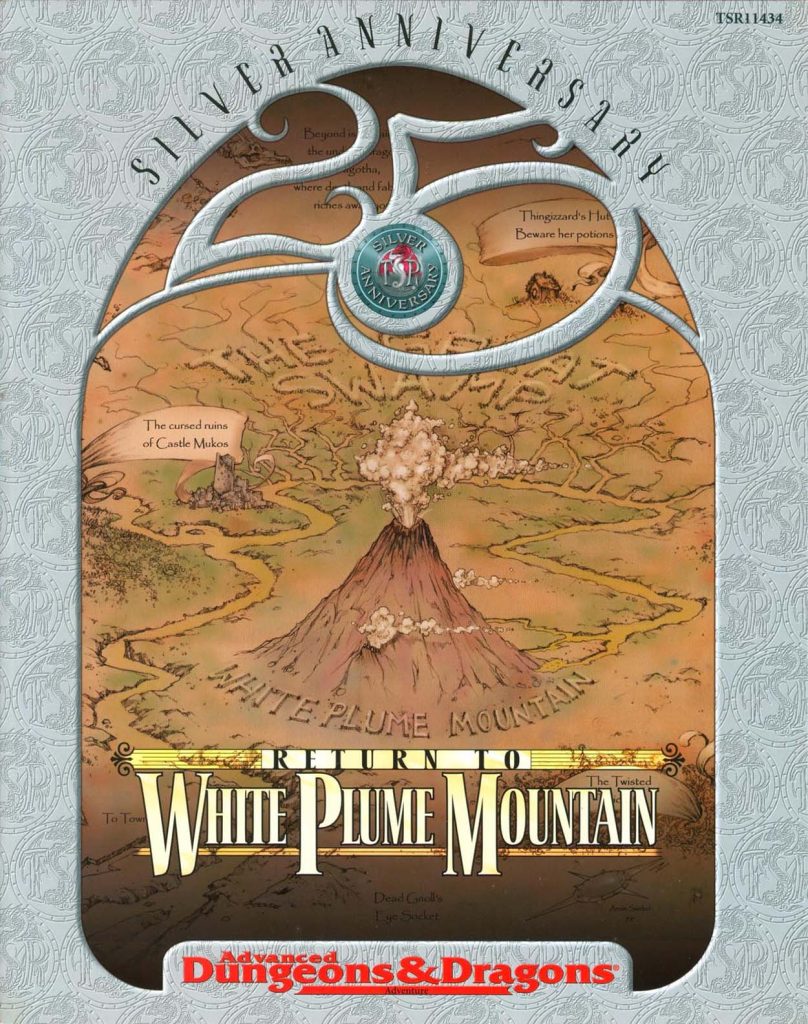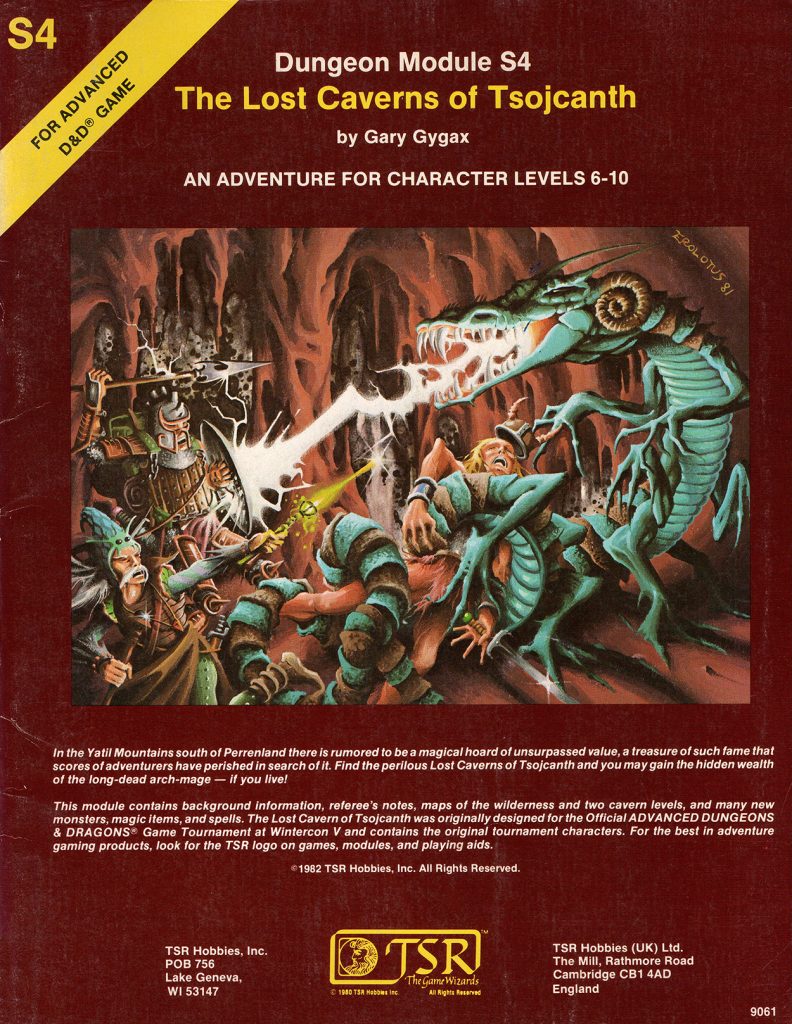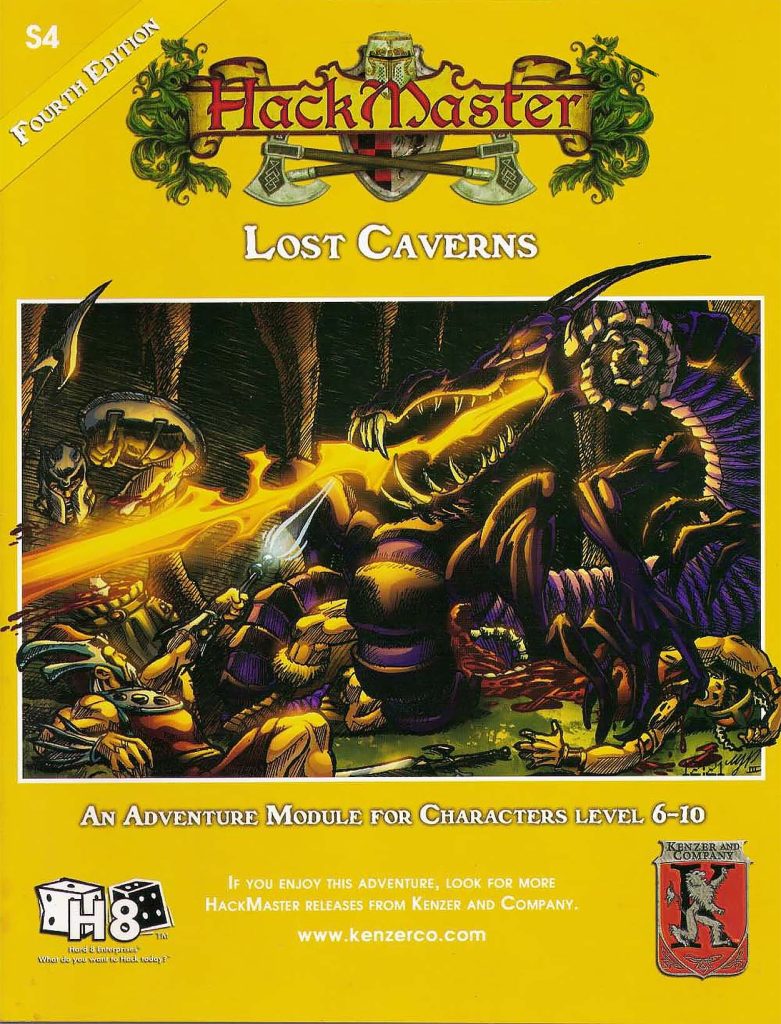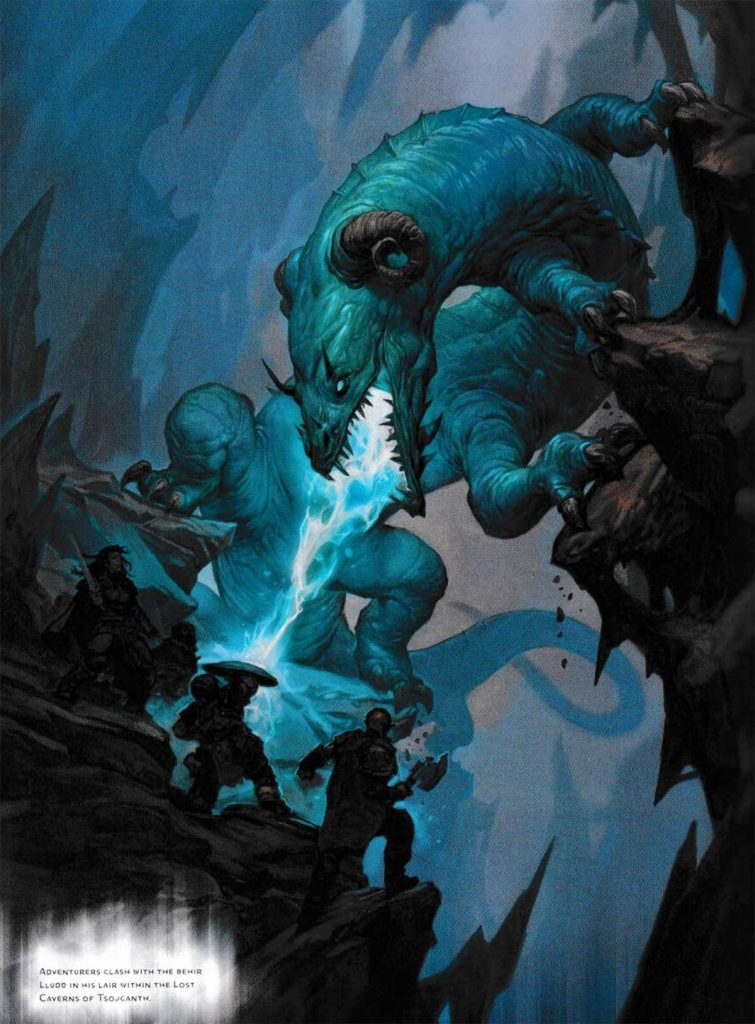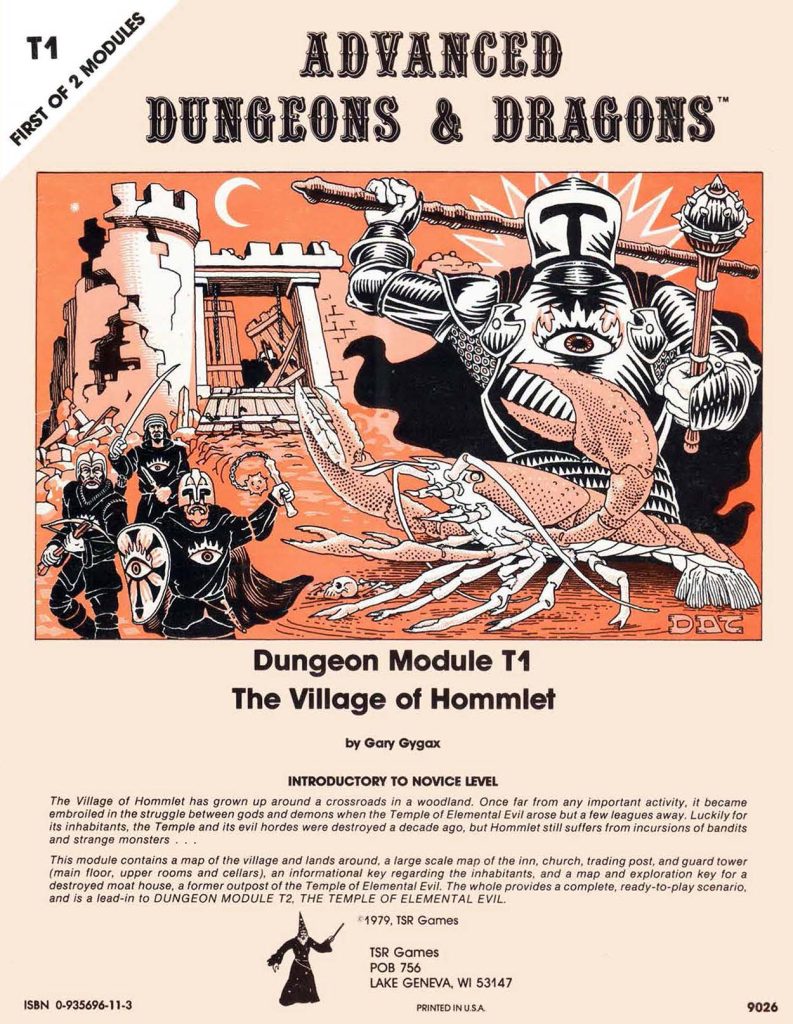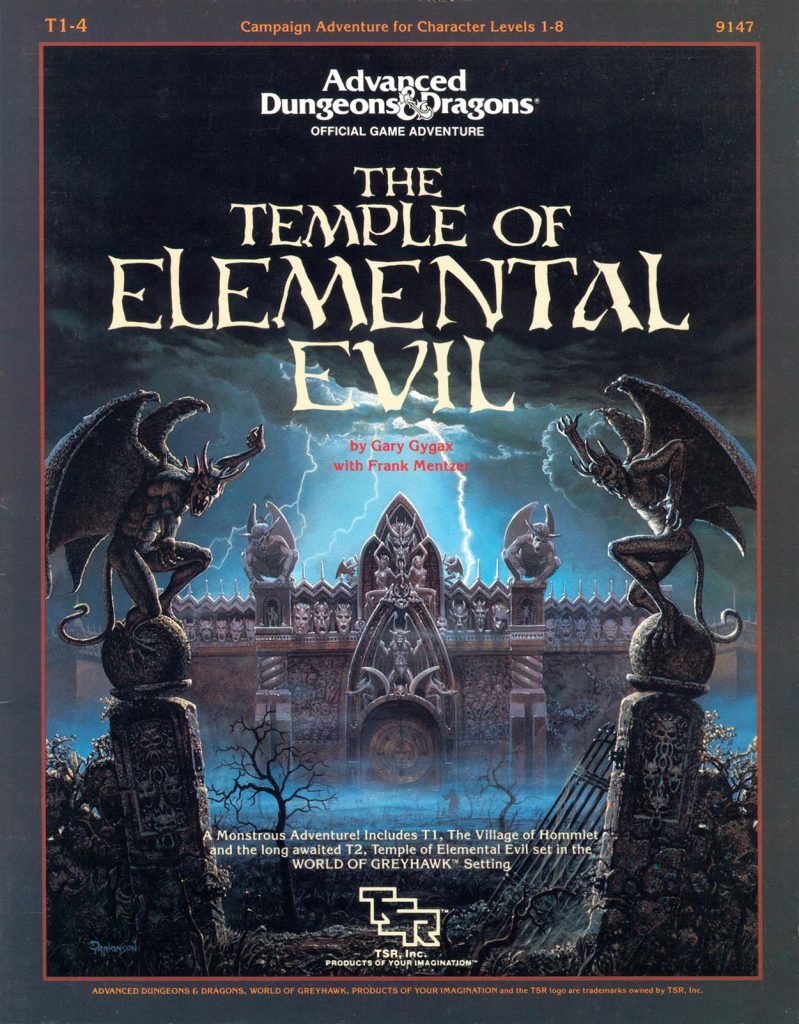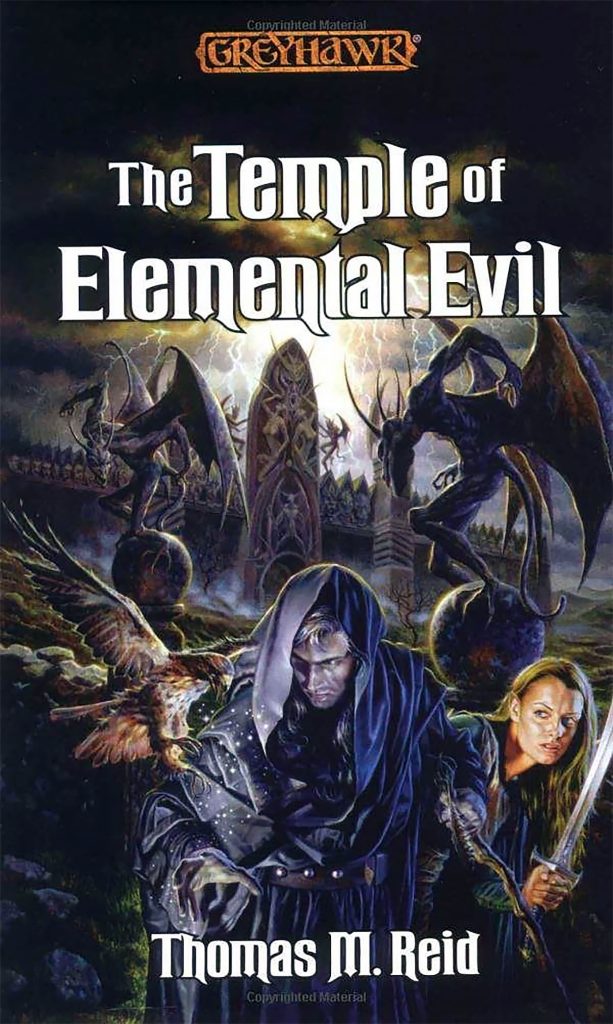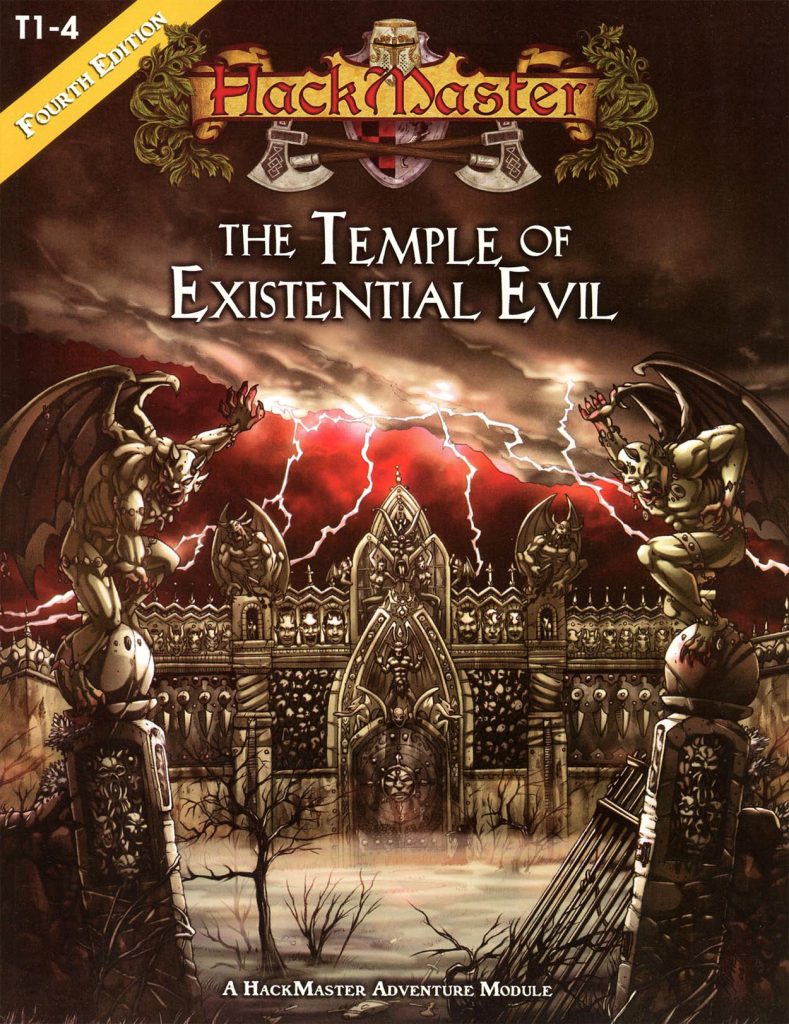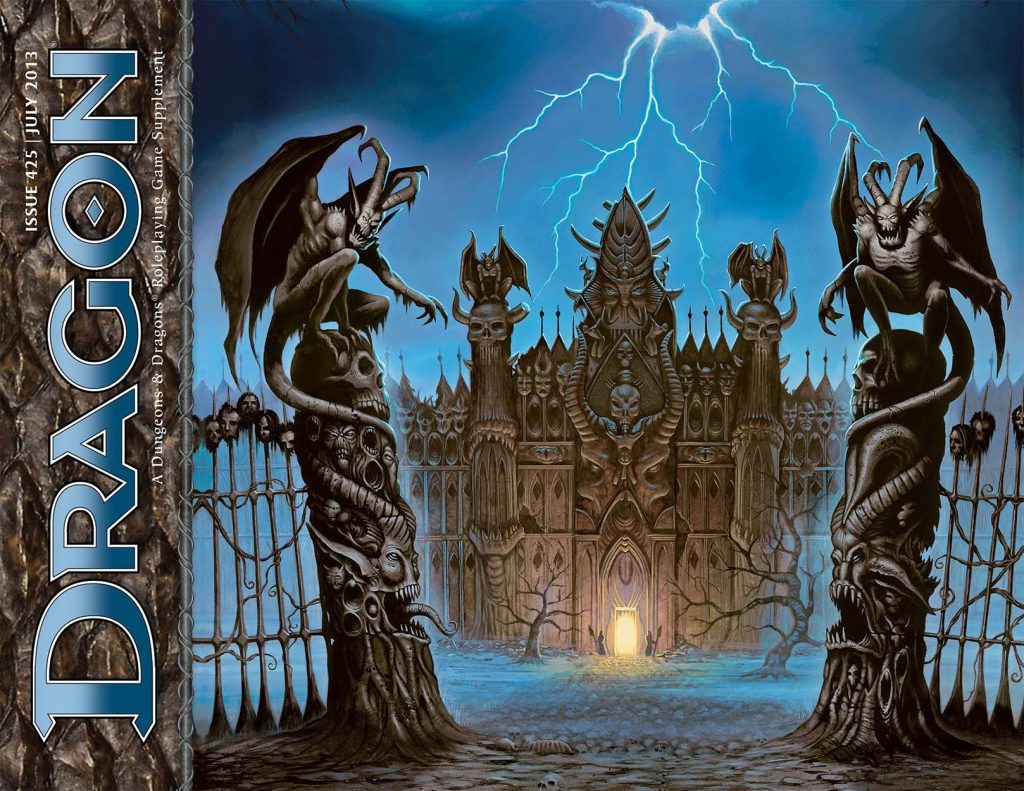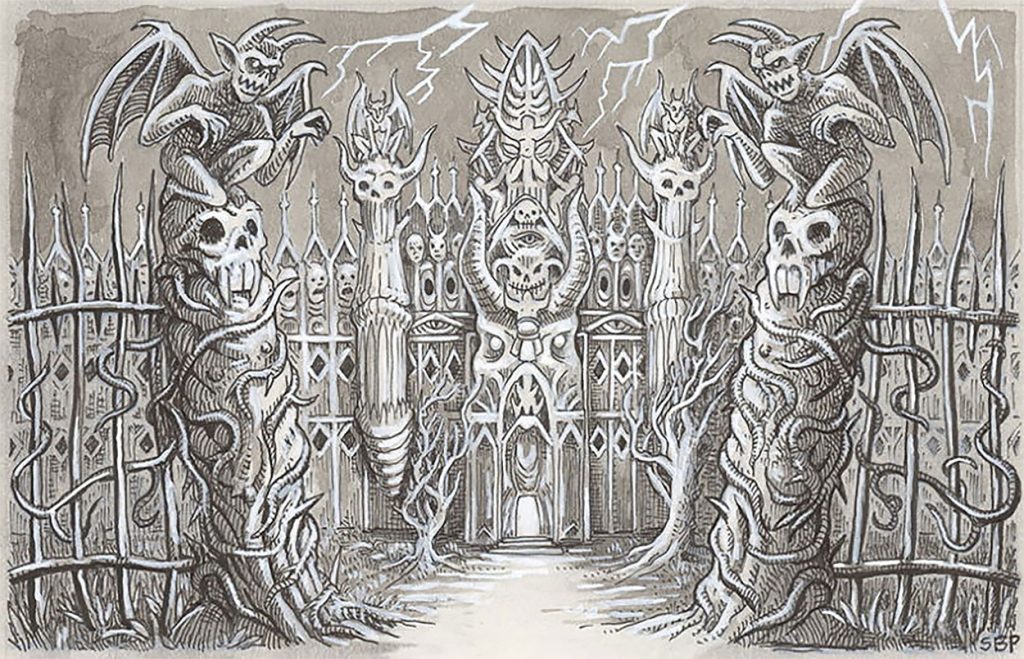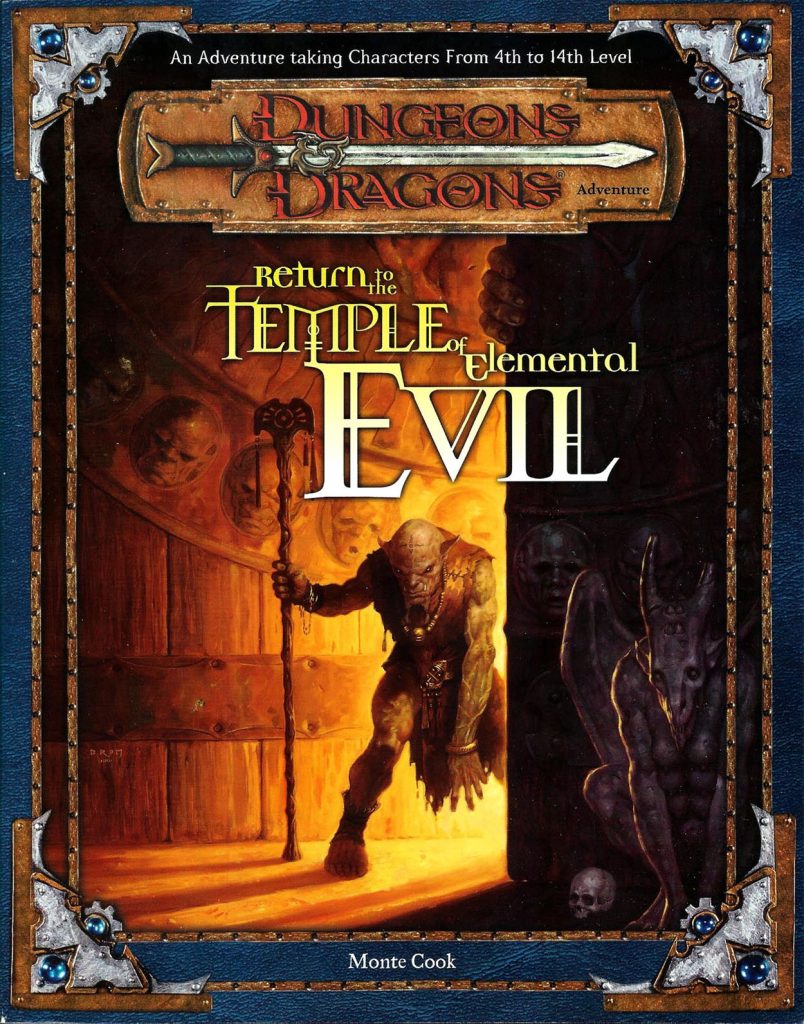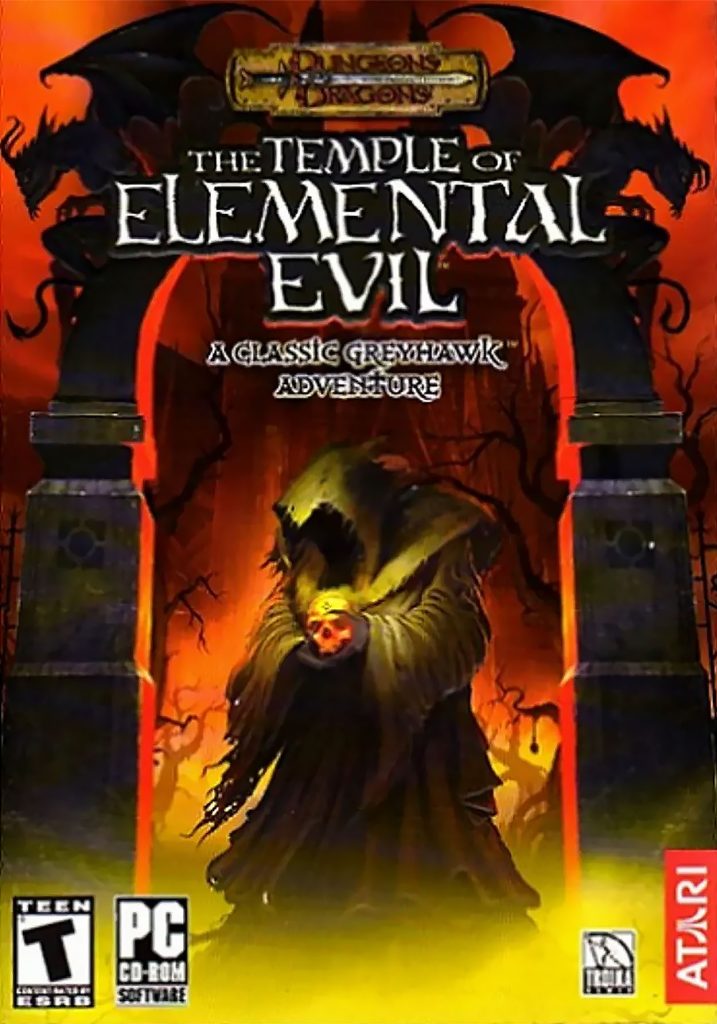AD&D 1e modules existed in three different forms. Starting in 1978, they were published with monochrome covers. Then in 1980, TSR’s fortunes were rising, and the covers became full cover. Both of these versions included the diagonal AD&D branding at top left. In 1983, the AD&D 1e branding was then updated with an orange level bar at the top (and much bolder branding). Adventure covers from all three eras have been homaged, but as with other homages, it’s the earliest era (approximately 1978-1982) that’s seen the most attention.
The adventure modules haven’t seen nearly as much homaging attention as the rulebooks, but thanks to Hackmaster Fourth Edition, there are homages for many of them. (And a few adventures have picked up homages from other sources as well.)
A1: Slave Pits of the Undercity (1980)
Hackmaster‘s Smackdown the Slavers (2002) demonstrates a pretty typical Hackmaster homage: an image a few minutes after the original art, where the adventurers are falling to their foes. But rather than homaging the cover of the collected A1-4: Scourge of the Slave Lords (1986), Kenzer & Company went back to the original, revisiting Jeff Dee’s cover to A1: Slave Pits of the Undercity (1980), the first in the Slave Lords series.
The Hackmaster back covers tended to include homages too, but in the case of Smackdown the Slavers, it’s just a new image of the ankylosaurus from the back cover of A3: Assault on the Aerie of the Slave Lords (1981) that’s so close-up that it’s no longer really an homage.
C1: The Hidden Shrine of Tamochan (1980)
C1: The Hidden Shrine of Tamoachan uniquely exists in three forms: a very limited “collector’s edition” that was sold when the adventure was originally run as a tournament (1979), the original mass-market version with a monochrome cover (1980) and a full-color cover in TSR’s revised format (1980). All three covers have been homaged (or at least referenced).
The original tournament adventure had a cover by David C. Sutherland III that showed a feathered serpent winding around a step pyramid. Erol Otus returned to the theme for the back-cover of the monochrome edition, then Jeff Dee did the same for the color edition. At least the last two are similar enough for Dee’s work to be an homage of Otus’, while the first is a variation of the theme.
Erol Otus illustrated the covers for both of the latter printings. For the monochrome edition, he drew a fire-breathing demon, which also appears as the cover to Hackmaster‘s C1: The Hidden Shrine (2003), and as an interior piece in Dungeon #141 (December 2006), which has an adventure returning to Tamoachan.
Finally, Otus depicted a different battle on the color cover, against a green ogre mage. This one showed up on the back cover of Hackmaster‘s C1: The Hidden Shrine (2003), as well as an interior page from Tales from the Yawning Portal (2017)—the latter being a collection of classic adventures converted to D&D 5e, each with a full-color illustration at the start that often referenced earlier artwork. The artwork for Tamoachan is particularly fun because in every other battle the ogre mage is pushing the adventurers up the stairs, but here it’s forcing them down instead. The gaming module variant of the comic Quest #5 (2025?), a comic that features an homaged variant for every issue, was recently revealed as the latest homage to Otus’ original.
C2: The Ghost Tower of Inverness (1980)
C2: The Ghost Tower of Inverness was another cover that had a limited-edition tournament release, this time with a cover by Erol Otus. That’s what Hackmaster choose to homage in C2: Demon Tower of Madness (2003).
Jim Roslof’s cover for the mass-market edition, with its ghosts emerging from the tower, is better known. Hackmaster homaged it on their back cover, and made the spectres more threateningly material.
There have been a number of returns to the ghost tower, including a Super Endless Quest book, a D&D Encounters season, and a Dungeon adventures, but surprisingly none of them referenced the original cover art.
D1-2: Descent into the Depths of the Earth (1981)
The cover for Hackmaster‘s D1-2: Descent into the Netherdeep (2003) did not originate from the cover of either of the two constituent modules, nor their compilation. Instead, the two cutest bugbears ever made their debut as a black-and-white interior piece in D1: Descent into the Depths of the Earth (1978).
The back cover for Descent into the Netherdeep was probably an homage to B1: In Search of the Unknown (1978).
G2: The Glacial Rift of the Frost Giant Jarl (1978)
For G1-3: Annihilate the Giants (2002), Kenzer & Company again decided to homage one of the modules that were included in the original, this time G2: The Glacial Rift of the Frost Giant Jarl (1978), whose cover was by Dave Trampier. A few years later, Revenge of the Giants (2009) from Wizards of the Coast also seemed to reference that piece, with another two frost giants, but this time facing a single adventurer. (The back cover of Annihilate the Giants is just a reprint of a black & white interior piece.)
G3: Hall of the Fire Giant King (1978)
The next giant adventure, G3: Hall of the Fire Giant King had a much more far-flung homage: the original D&D 5 Player’s Handbook (2014). Though the overall framing is different, the costuming of the fire giant antagonist, Snurre, match David Sutherland’s original exactly.
G1-2-3: Against the Giants (1981)
Finally, Bill Willingham’s cover for the compilation, G1-2-3: Against the Giants, was homaged in the interior chapter divide for the adventure in Tales from the Yawning Portal (2017). Though the city landscape of the original is gone, and a storm giant has been added looming overhead, the fire giant, hill giant, and frost giant of the original return with just the same positioning.
There are a few other variants that seem close kin: the Against the Giants novel (1999) shows a battle with a single frost giant in snow, while the roleplaying sequel Against the Giants: The Liberation of Geoff (1999) shows more giants invading a city, but neither is an homage.
I2: Tomb of the Lizard King (1982)
As the earliest of the orange banner adventures, I2: Tomb of the Lizard King falls outside of the era most rich for homaging. Nonetheless, Hackmaster included an homage to Harry Quinn’s cover on their I2: Crypt of the Lizard King (2004). (The back cover is another interior piece of black and white art that wasn’t necessarily an homage.)
I3: Pharoah (1983)
Almost all of the later era cover artwork that’s been homaged came from a single series, the “I” Intermediate adventures. The cover of I3: Pharoah, by Jim Holloway, was homaged by the chapter divider for “Pharaoh” in Quests from the Infinite Staircase (2024), the second book of classic adventures for D&D 5e.
I6: Ravenloft (1983)
Next up among the “I”s is I6: Ravenloft. Clyde Caldwell’s artwork of Count Von Strahd overlooking his domain from a gargoyle-inhabited balcony was so iconic that TSR endlessly reused it. Shown here are the Super Endless Quest Adventure Gamebook Master of Ravenloft (1986) and the original printing of the novel I, Strahd (1993). But the artwork also appeared in black and white in RM4: House of Strahd (1993), as the cover of the Ravenloft Silver Anniversary Edition (1999), and likely elsewhere.
The references to the cover started with what has to be called a swipe, used on the cover of the video game Castlevania 2: Simon’s Quest (1987). But there are at least two proper homages, for Hackmaster’s Robinloft (2002) and Wizards’ Expedition to Castle Ravenloft (2006)—the latter rotating the camera so we see the Count head on.
There have been piles of different depictions of the Count over the years. Where the original leaned toward movie (or perhaps comic-book) Dracula, others have shown Strahd looking more monstrous or more modern. One of the most recent depictions of Strahd, for Curse of Strahd (2016) depicted him as a somewhat younger character who drinks his blood out of a goblet. (He looks a little more mature in one of the interior pieces, but is unable to give up the blood-wine habit.) This particular version of Strahd is notable because a DM’s Guild supplement, the Curse of Strahd Companion (2023) reenvisions that version of the character, but depicts him on a balcony, just like Caldwell’s original.
I10: Ravenloft II — The House on Gryphon Hill (1986)
When Clyde Caldwell returned to Strahd for the cover for Ravenloft II: The House on Gryphon Hill (1986), he got Strahd down off his balcony, to have a walkabout with an innocent victim—a pose that was as usual parodied by Hackmaster, this time as Robinloft 2: Tahd’s Legacy (2004).
But this time, it seems likely that Caldwell had an inspiration: Marvel’s The Tomb of Dracula #1 (April 1972). There’s (probably) just too much in common for it to be a coincidence, including the blonde victim, the ground-level mist, the lefthand moon, the precise positioning of the Count’s hands and even his costuming (though movie depictions might have inspired the costuming in both).
Ravenloft II has only been homaged for Robinloft 2, but the Tomb of Dracula #1 has been homaged many times, including in The Tomb of Dracula magazine #1 (October 1979), Carnage #6 (May 2016), and Deadpool #1 (April 2024). (There are several more, many of them pretty small press.)
Note that the main difference between Ravenloft II and The Tomb of Dracula (and their homages) is the positioning of the castle: far in the distance in The Tomb of Dracula, but just behind the Count in Ravenloft II.
But here’s an argument against Ravenloft II‘s cover being inspired by The Tomb of Dracula: the trope of a vampire carring away a female victim was a common one. It appeared at least as far back as the movie poster for Horror of Dracula (1958), which itself was homaged in another Marvel magazine, Dracula Lives! #11 (March 1975). Caldwell even returned to the trope for his third outing with Strahd, Ravenloft: Realm of Terror (1990).
S1: Tomb of Horrors (1978)
S1: Tomb of Horrors is definitely one of AD&D’s classics, so it of course was parodied by Hackmaster, as S1: Tomb of Unspeakable Horrors (2003).
But the cover of Tomb of Horrors was never the most iconic thing about it (neither the full-color cover shown here, nor the earlier monochrome cover). Instead, some of the dungeon’s features, illustrated in its picture book, are what’s most memorable.
The initial hallway in the Tomb of Horrors is certainly up there. Tales from the Yawning Portal (2017) offered an attractive color reproduction.
However, Dave Trampier’s depiction of the head at the end of that hallway, which at least one source calls “The Devourer,” is what really stands out in the interior art. It could easily be as iconic as his idol for the cover of the Players Handbook (1978). TSR seemed to recognize this from the start, as Erol Otus depicted it on the back cover of the original Tomb of Horrors. Then, years later, when Wizards of the Coast reprinted the adventure in S1: Dungeons of Dread (2014), they featured a new version of the Devourer on the cover. most of the other covers from that series excerpted elements from the original covers, so this was a notable change that showed the importance of this piece of art.
The first two sequels to Tomb of Horrors, Return to the Tomb of Horrors (1998) and the 4e Tomb of Horrors (2010), each featured the Devourer extensively, both in cover art and interior art. They also turned it into a trope, as both featured similar heads in other locations than the end of that first corridor.
Most recently, the Devourer showed up in the Greyhawk section of the 2024 edition of the Dungeon Master’s Guide (2024), again showing its importance as a central icon of D&D play.
S2: White Plume Mountain (1979)
S2: White Plume Mountain exists with both a monochrome (1979) cover by Dave Sutherland and a color (1980) cover by Jeff Dee. They’re not exactly homages, but they both continue the same theme: a party under assault by manticore. S2: White Doom Mountain (2003) repeats that theme on its back cover.
But the back cover of the original White Plume Mountain might be more iconic with its image of adventurers examining a tooting mountain. When TSR put together S1-4: Realms of Horror (1987), they mostly montaged homages of interior artwork, but they couldn’t resist the mountain. That’s also what Kenzer & Company also choose for the front cover of their White Doom Mountain, but with a fun twist: note the minotaurs approaching the adventurers. The front and back covers of White Doom Mountain are a sequence, something that TSR never did with its original covers.
But the most famous artwork in White Plume Mountain is surely the map that introduced Dragotha—which only showed up in the second (1980) printing, when TSR needed to fill in a few pages to expand the adventure from 12 to 16 pages. That map was homaged as the cover for Return to White Plume Mountain (1999) and was also updated for Tales from the Yawning Portal (2017).
S4: The Lost Caverns of Tsojcanth (1982)
S4: The Lost Caverns of Tsojcanth is probably a popular source of homages because of the amazing behir drawn by Erol Otus. S4: Lost Caverns (2004) for Hackmaster, Quest #1 (2023), and The Timeless Caverns Boxed Set (2025) all homaged the piece pretty precisely (the last flipped right to left), while the chapter divider for the adventure in Quests from the Infinite Staircase (2024) was slightly more varied.
T1: The Village of Hommlet (1979, 1981)
Dave Trampier’s artwork for the monochrome version of T1: The Village of Hommlet received a slightly varied homage in Warlock #20 (2017). But, there are some interesting details, like the introduction of the Lolth worshippers to the cover.
T1-4: The Temple of Elemental Evil (1985)
That finally leads us to T1-4: The Temple of Elemental Evil. It’s another module slightly outside of the most classic era, but Keith Parkinson’s illustration of the Temple may be one of the most iconic in the AD&D era. The Temple of Elemental Evil novel (2001) offered one of the most interesting homages because it placed some characters in the frame. Everything else just tried to offer slight variants of Parkinson’s original, including T1-4: The Temple of Existential Evil (2003) for Hackmaster, Dragon #425 (July 2013), and an interior piece for Goodman Games’ Original Adventures Reincarnated #6: The Temple of Elemental Evil (2021)
Two other homages focus on individual elements of the original Parkinson painting (and are much weaker homages as a result). Return to the Temple of Elemental Evil (2001) cocentrates on the door, but it’s obviously the same as the one in the original from the circle on the door. Also, one of the gargoyles from the gate stands nearby. The computer game (2003) focuses on that gate, and though it’s style and design has changed, the two gargoyles mark it as the same structure (just like the ever-present gargoyles in the original Ravenloft).
Versioning Notes & Credits
v1.0.0 (7/27/25). Thanks to @wolfgangbaur.bsky.social for pointing out Warlock #20 for T1. Thanks to eldritch at the Fraternity of Shadows for identifying the weird Castlevania plagiarism of I6. Again, thanks to TSR Archive for some cover scans, particularly Hackmaster and back covers this time around.

